Heligoland in winter is an interesting place to observe grey seals in their natural habitat, as every year from November to January moms give birth to their young on the "Düne" (English: dune). During the cubbing season and the following breeding season, grey seals stay on or close to the Düne of Heligoland. I have visited Heligoland and the grey seals on the Düne in one winter and tell you here more about my impressions.
Heligoland in winter
Lions or elephants in Africa. Whale watching off the coast of Hawaii. Or spotting a jaguar in the Brazilian Pantanal. Of course, by all means very special animal encounters. But sometimes you do not have to travel long distances to find a special moment with wildlife. I have to confess. Often I wish to see places far away. Often I’m full of longing for the sea, the mountains, forests or other places of natural beauty with animals always playing a central role in my dreams. But where can I find this in an industrialized country like Germany? Well, although all those urban jungles and agricultural areas do look sometimes grey or depressing (especially in winter), I have to admit, there are still some places really interesting to get a mention and worth a visit in winter.
And this is Heligoland (German: "Helgoland").
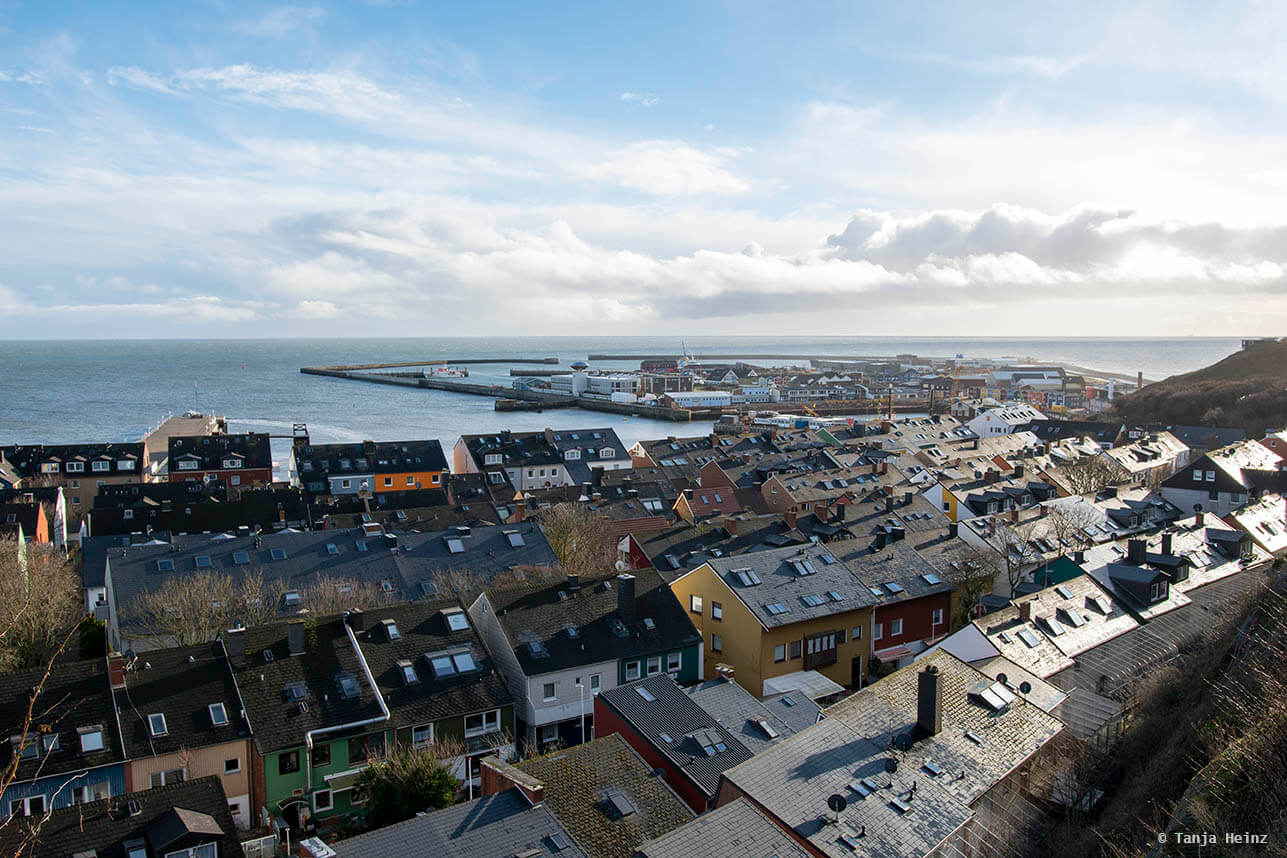
Heligoland is the only high sea island in Germany and about 70 kilometers offshore the mainland from Cuxhaven. Heligoland is a small archipelago in the North Sea in the state Schleswig-Holstein comprising the main island and a small island just next to it - the Düne - where two seal species live.

Before I tell you more about the grey seals and why I have visited Heligoland in winter, let me represent the island Heligoland first, as I got some stunning impressions of this special place in winter. Maybe the sunny weather contributed to my positive sensation of the island (although it was really cold). Or because I could experience a magical sunset and met very friendly and relaxed people there. Or because Heligoland is a quiet place far from busy and frantic cities? I do not know, but I very enjoyed three full days in winter on Heligoland.
Only on my first day it was very cloudy and rainy. However, the weather didn’t stop me exploring the island. My explorations were worth every minute. I became witness of soothing and harmonious colors and the sea was rough.
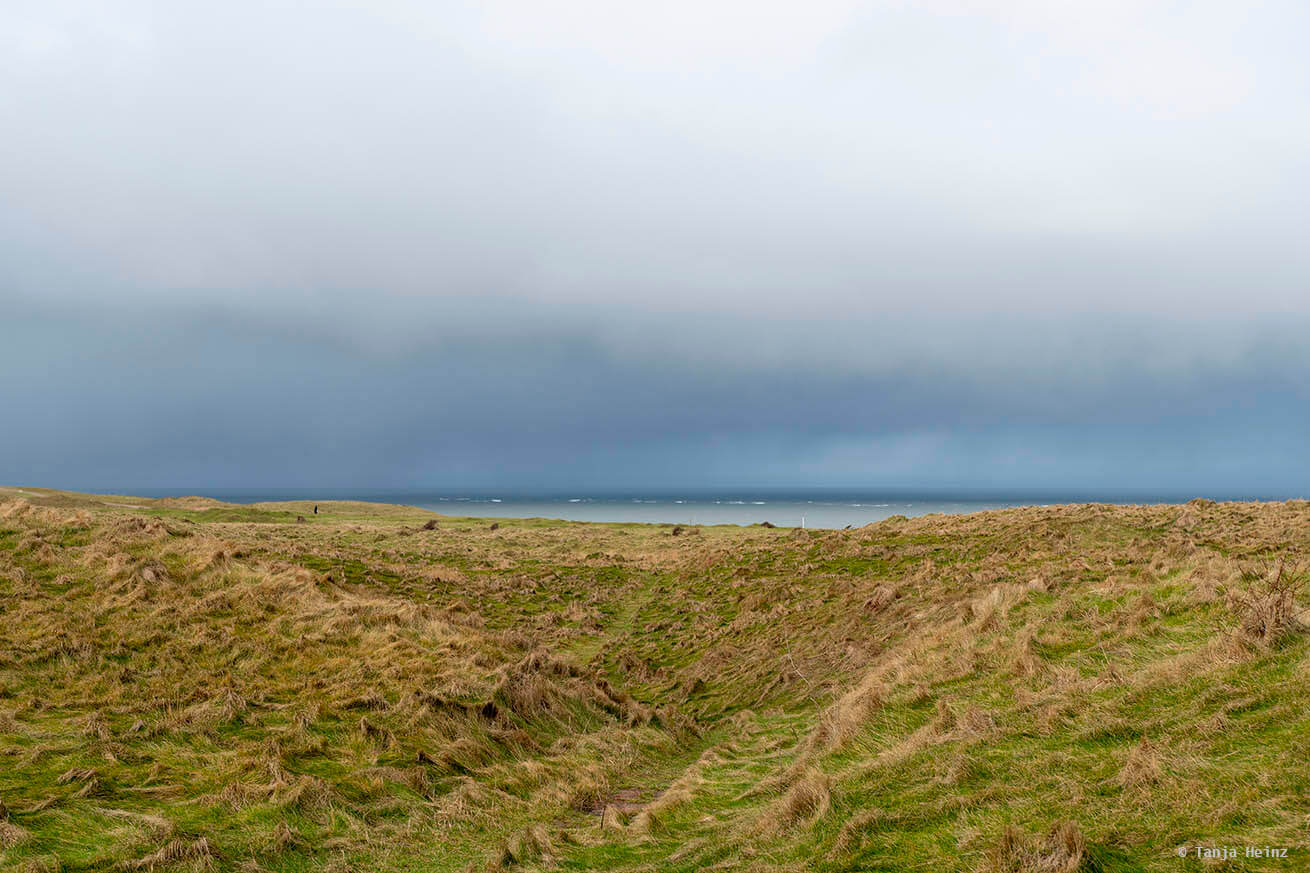

I went around the whole island and became aware of other people far away. I was not the only one outside.

Indeed, in winter you might feel quite alone on the island on some days. Especially when it’s cold and rainy. Many restaurants are closed and only few people stir out of their houses - especially on a bad weather day.
The main island of Heligoland is very small. About four square kilometers constitute the island and there are only about 1.200 inhabitants on Heligoland. Cars are prohibited on the island. You can see only some taxis or vehicles from construction workers on the streets.
A very relaxing place I have to say.
One main attraction on the island is definitely "Long Anna" or "Tall Anna" (German: "Lange Anna").
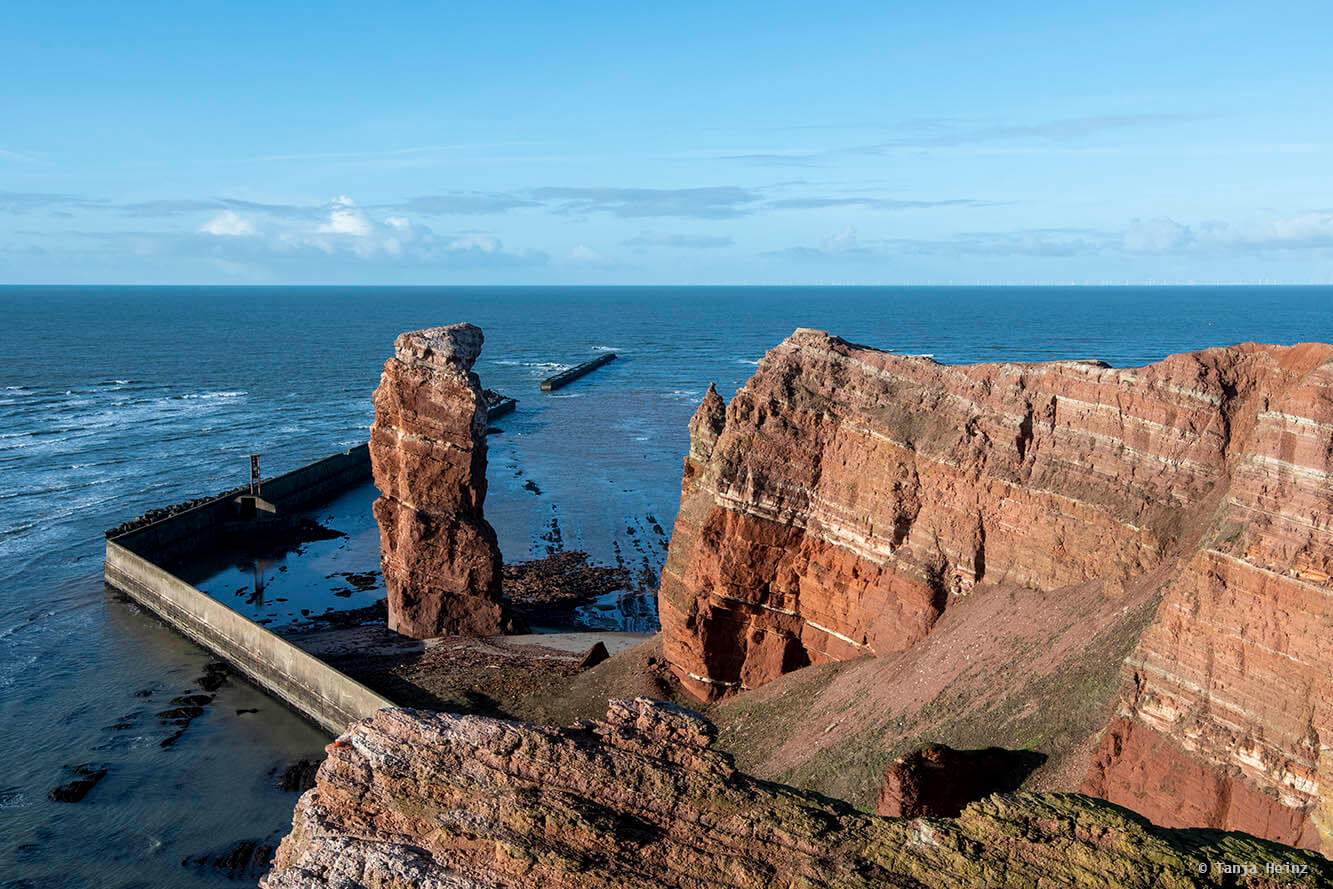
Long Anna is Heligoland’s landmark and a free-standing and 47 meters high rock column consisting of red sandstone. The original name of Long Anna is actually Nathurn Stak according to the local language. The name "Long Anna" apparently first appeared in the years before the First World War. Probably, the name is dedicated to a tall and beautiful woman who was working in a café in the north of Heligoland.
Long Anna was connected to the mainland until the 16th May of 1860. Since then Long Anna is a monolith. At the beginning of the 20th century a wall was built in order to protect Long Anna from the surge of waves. In 1979 a cavity on the ground had to be walled up in order to prevent a collapse. But due to more weathering processes, Long Anna is left to its fate and probably will collapse sooner or later...
Tip: On a walk on Heligoland’s main island you can also learn more about the history of the island. For example, did you know that all inhabitants of Heligoland had to leave the island after the begin of the First World War, as they had to make way for soldiers of the marine? The people of Heligoland came back after the war and had built up the island again, but by the end of the Second World War Heligoland was completely destroyed by the English army and the inhabitants had to leave their home again...
Heligoland is divided into a Lower Land (German: "Unterland") and a Upper Land (German: "Oberland") with an elevation of about 40 meters above sea level. There is a lighthouse on the Upper Land and close-by you can get nice views onto the harbor.

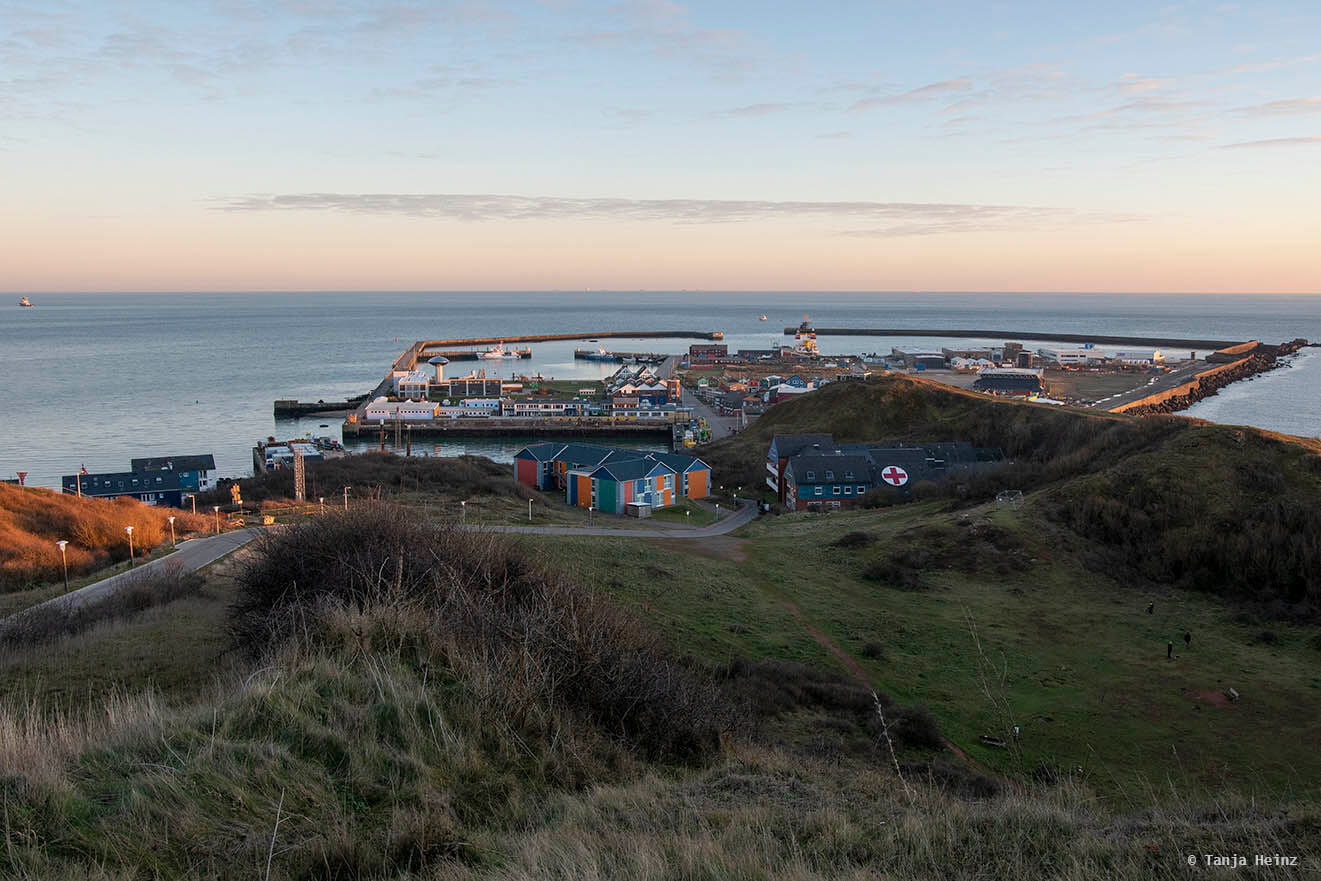
Of course, especially in winter you need luck with the weather. I fortunately had chosen the right days for a visit. I spent three complete days on Heligoland. My days looked like this: observing grey seals in the morning until midday, then a break for lunch followed by a long walk around the island and a warm and relaxing evening at my accommodation. I traveled alone to Heligoland and enjoyed it very much being all by myself. On one afternoon I became witness of a magical sunset. Wow. Just see the photographs. I don’t have words for this.
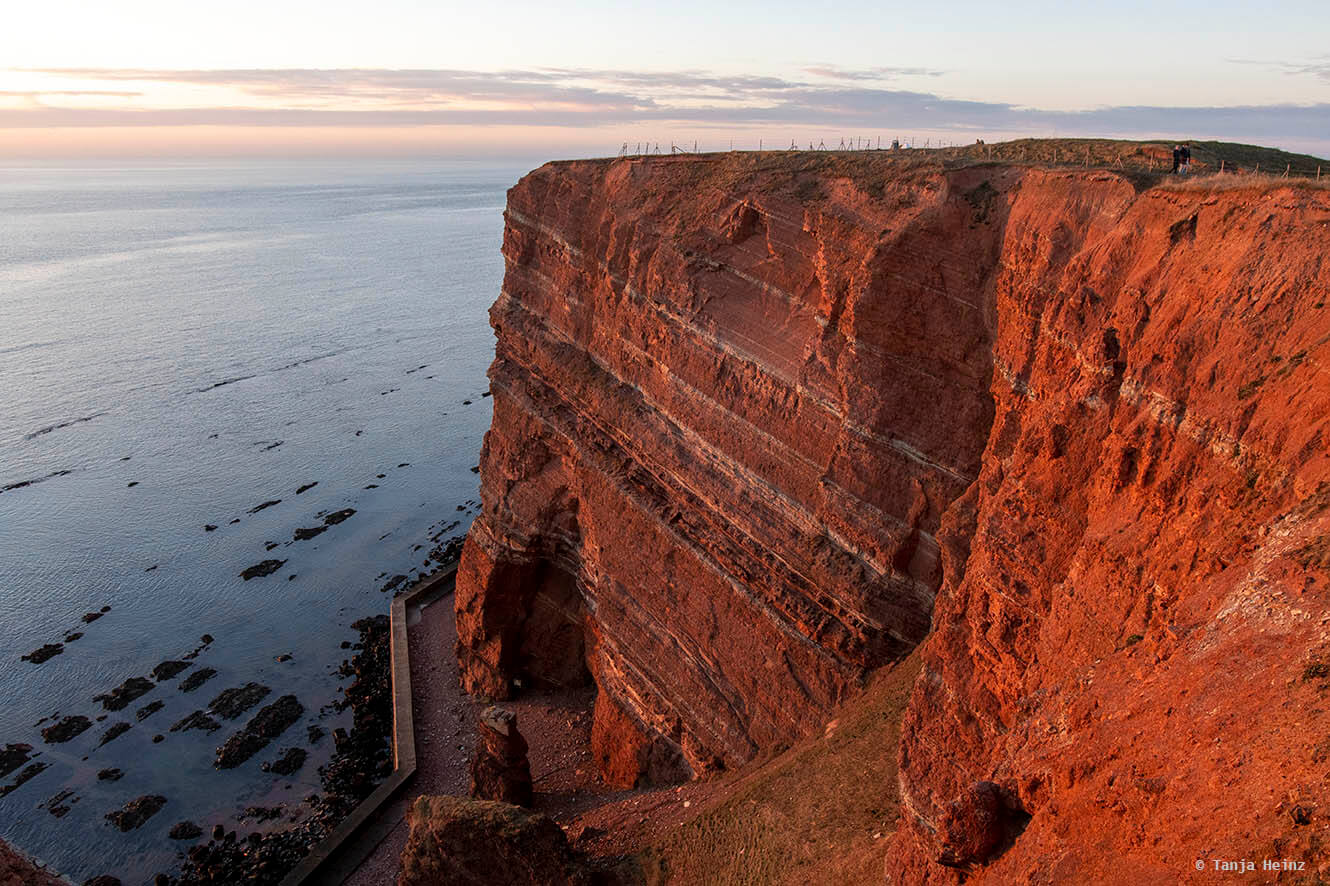
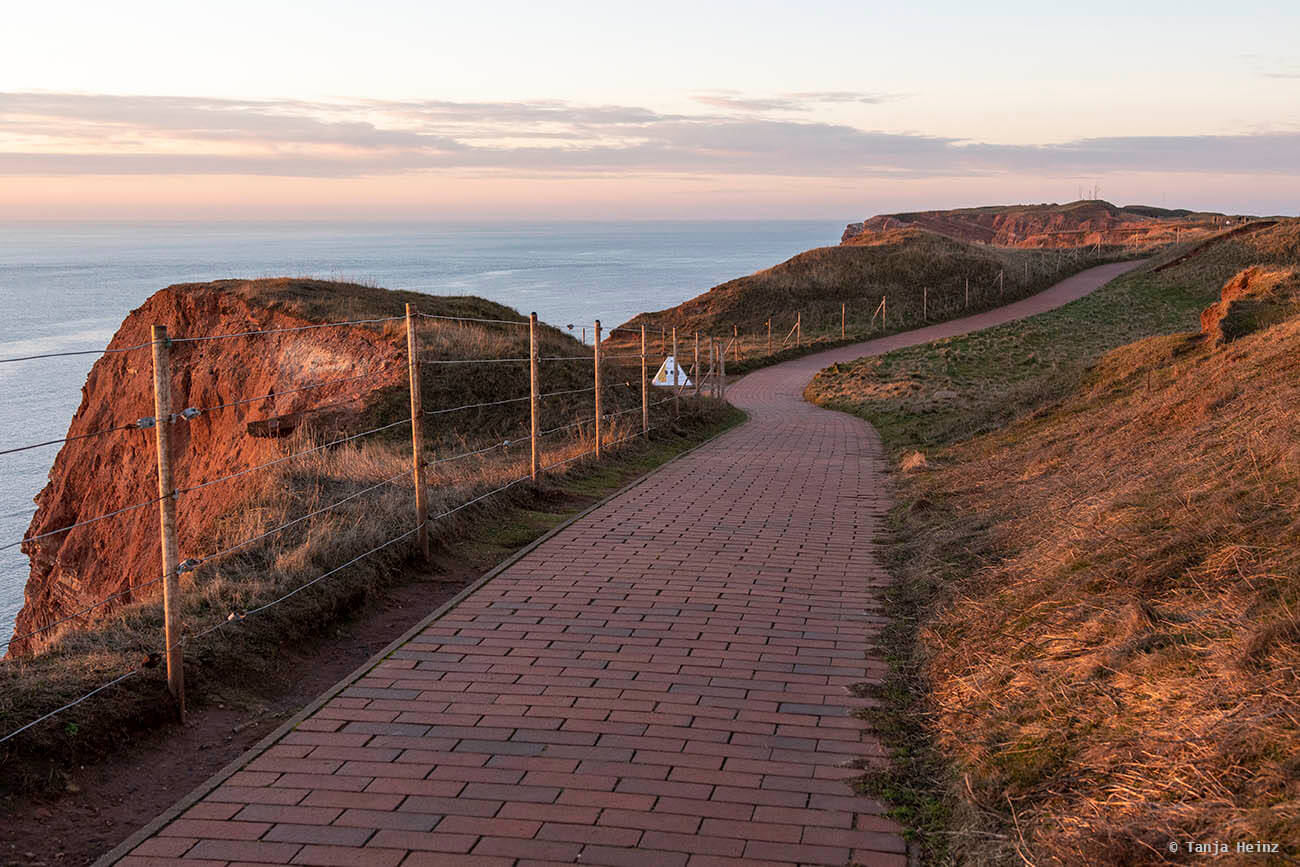
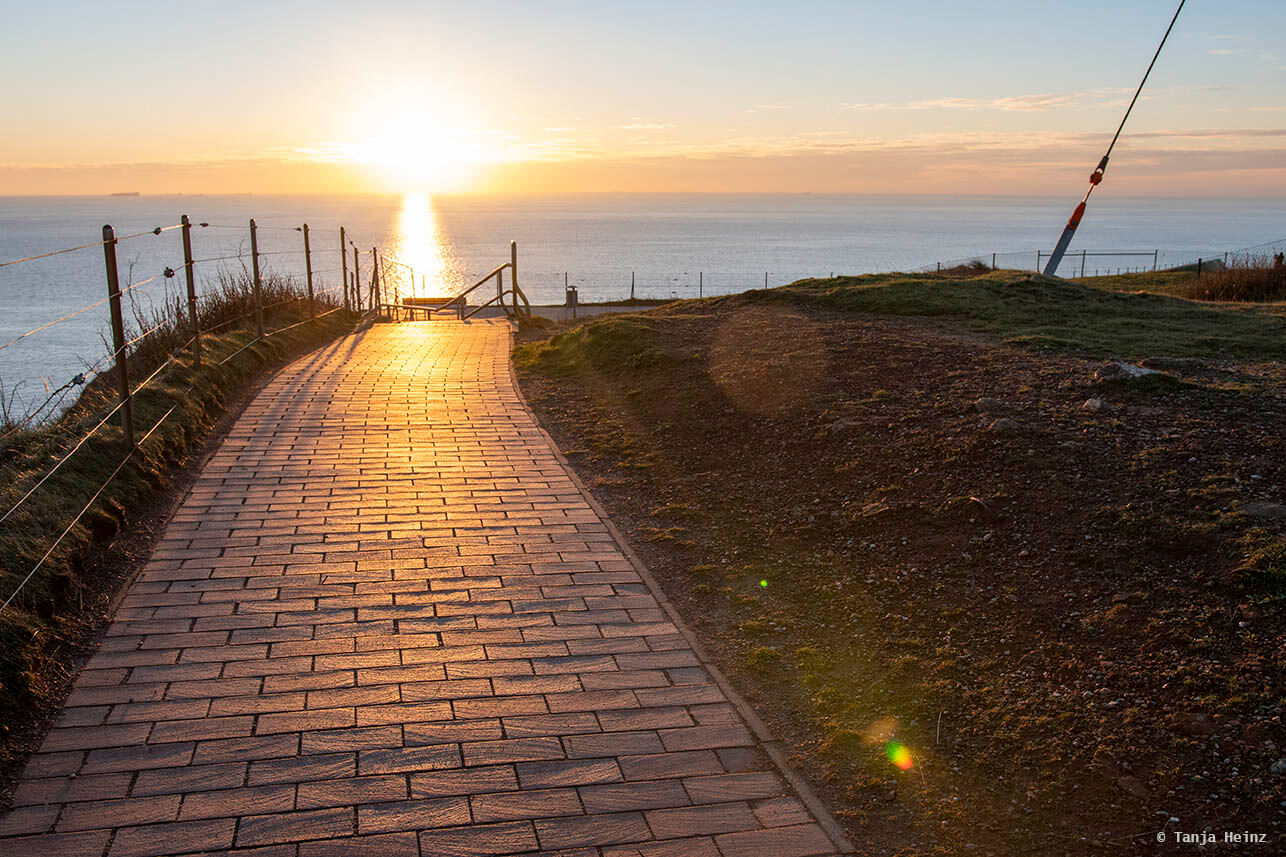
On the mainland of Heligoland you will find no seals, but on the Düne just next to the main island. Let me give you some more impressions of the place before I come to the actual topic of this blog entry: grey seals.
Tip: If you want to know more about Heligoland, there is a museum in the northeast where you can learn more about the history of the high sea island. Please visit their website to get more information about what you can expect to learn there.
Grey seals on Heligoland
On the island of Düne
The Düne is the smaller island of the archipelago of Heligoland. In the past, the Düne was actually connected with the main island, but after a big storm surge at the beginning of the 18th century both islands became separated from each other. If you want to visit the Düne you have to do this either by ferry or by airplane (but not from the main island, as there is no airport).
Although the Düne is home to two seal species - grey seals and common seals - a small airport (German: "Flugplatz Helgoland-Düne") is located on the flat sand island.

I was quite surprised about this. On my first day I realized that it is even possible to book an accommodation in a bungalow on the Düne. Although all this was a little bit suspicious to me, as seals live on the Düne, I have to admit, that these little bungalows look very comfortable and it seemed to me a place where you can be accommodated at a nice place close to nature.
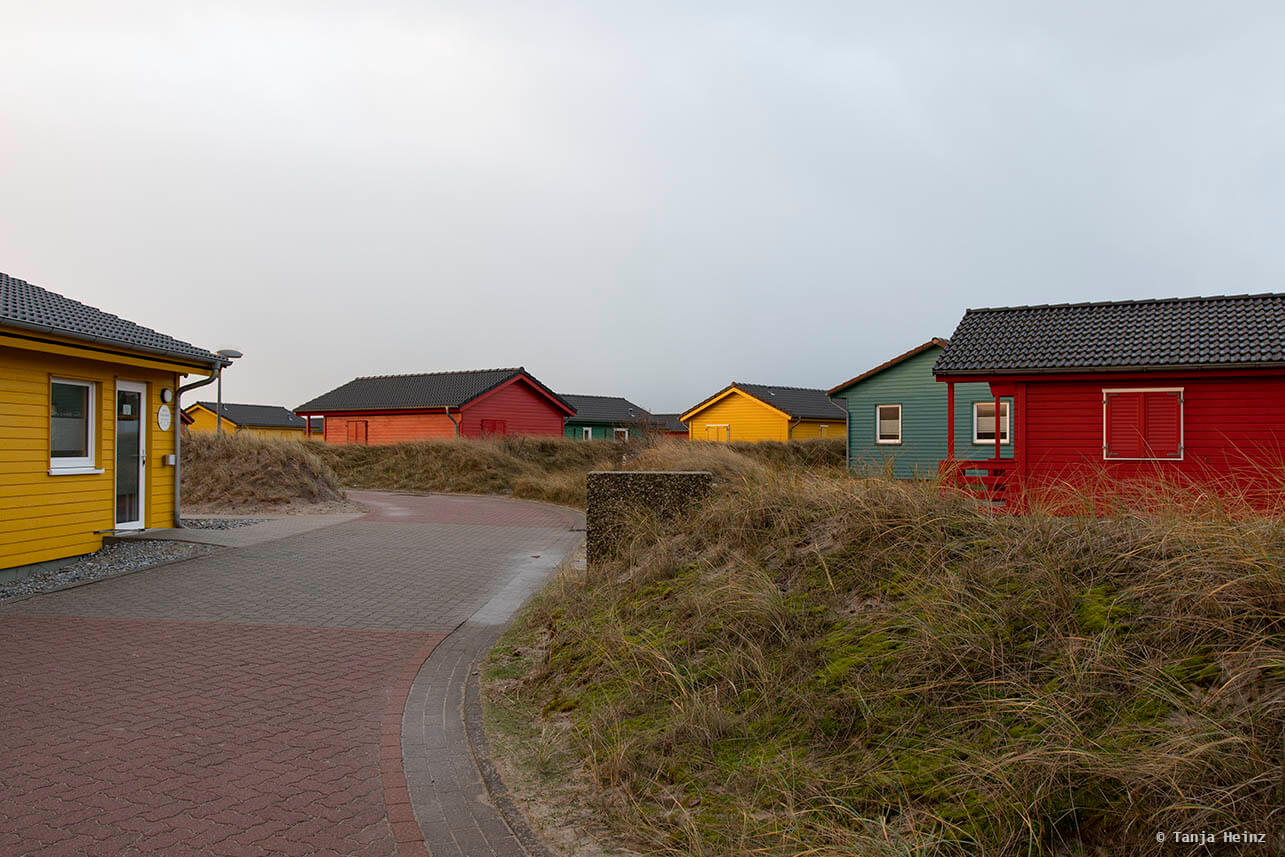

On that winter day on the Düne, it was still a construction site, but now it is possible to stay in one of these bungalows. Anyway, I was more interested to observe grey seals on that day than looking at man-made houses close to an important habitat of wild animals.
Before I met the grey seals, I was strolling from the ferry terminal further south into the direction of the southern beach (German: "Südstrand") where the lighthouse Helgoland-Düne is located.
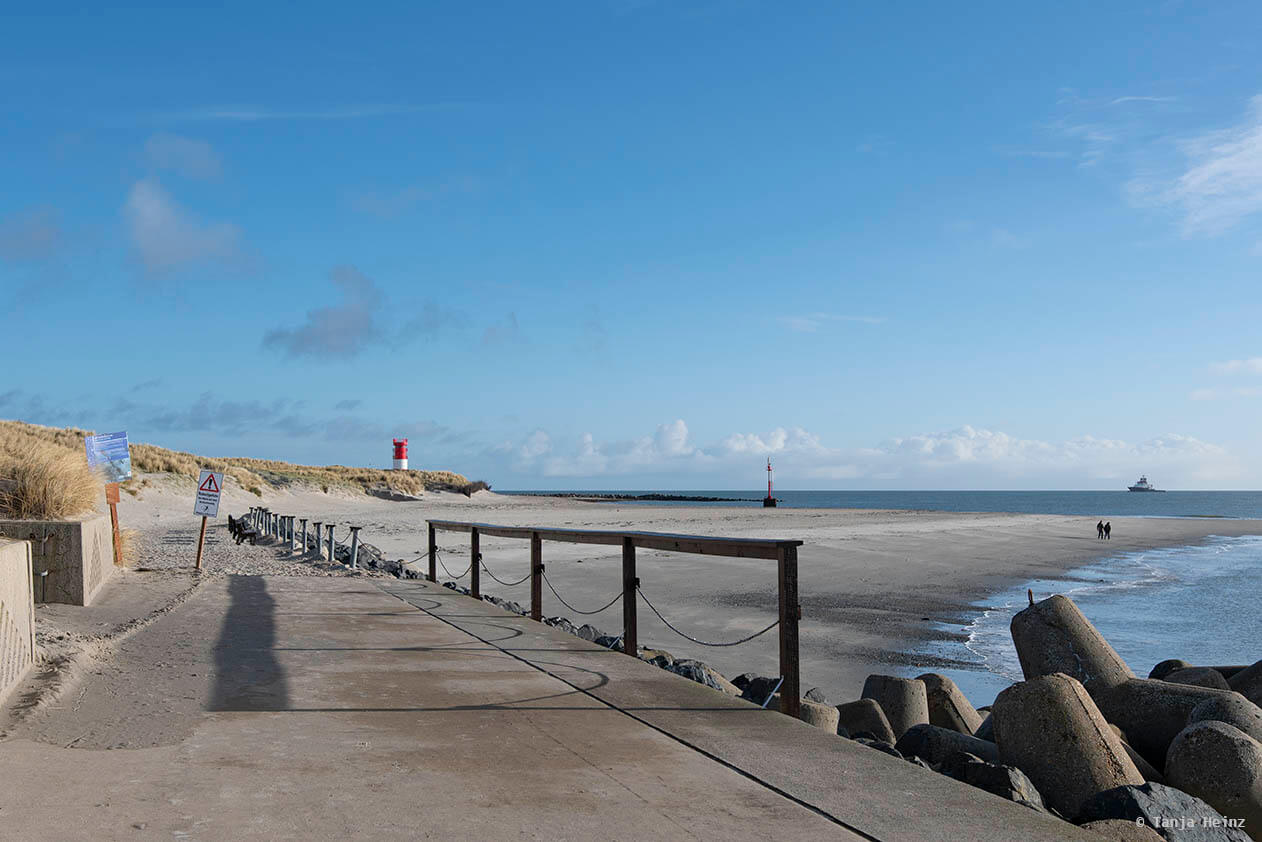
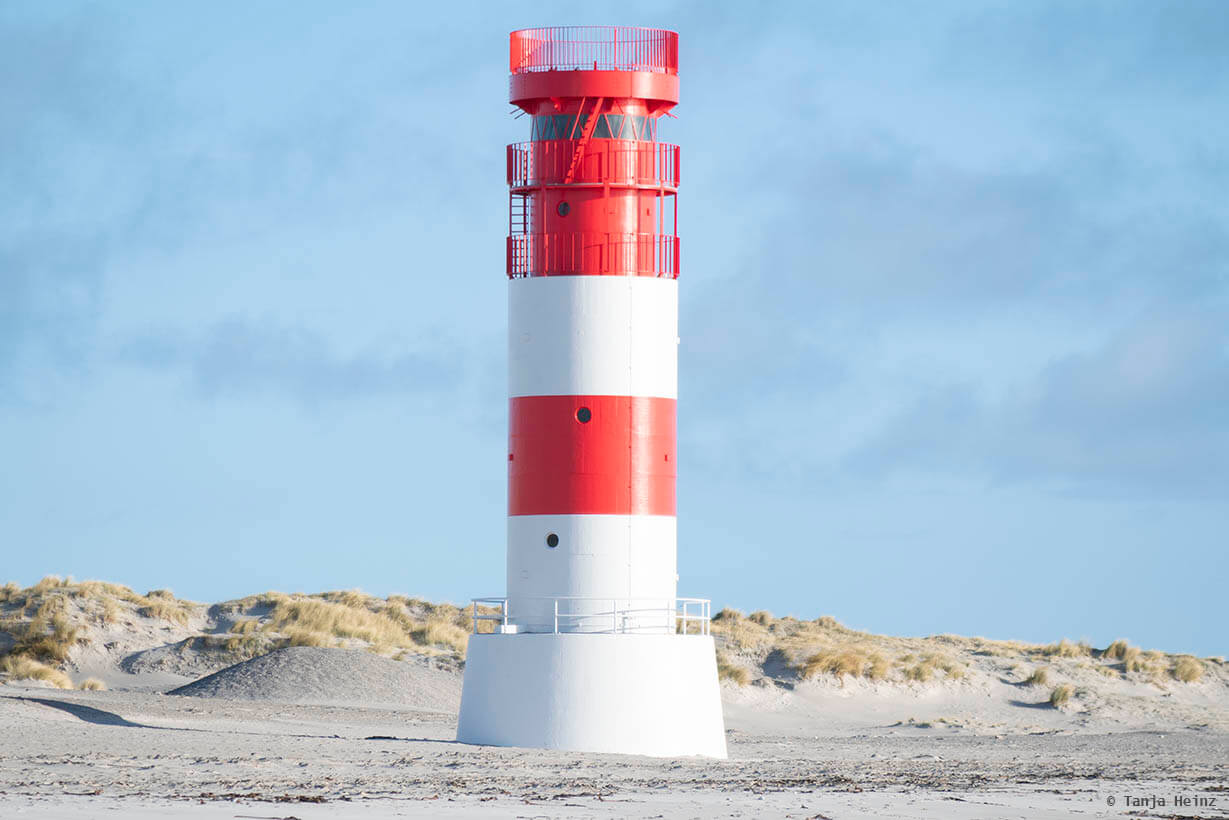
However, on my first morning I did not stop at the Südstrand, but was walking through the center of the Düne.
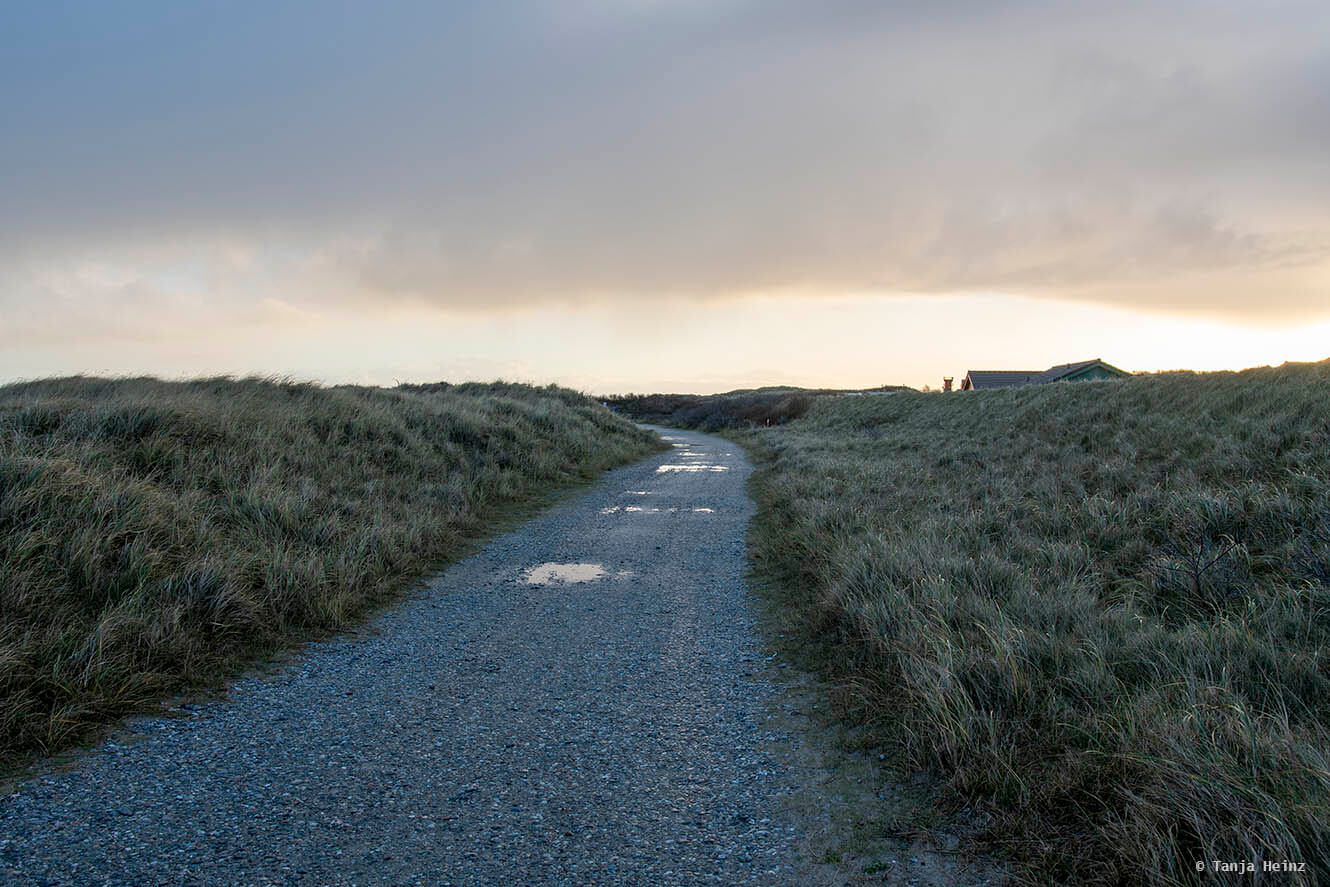
At some points you can glimpse at the main island of Heligoland.
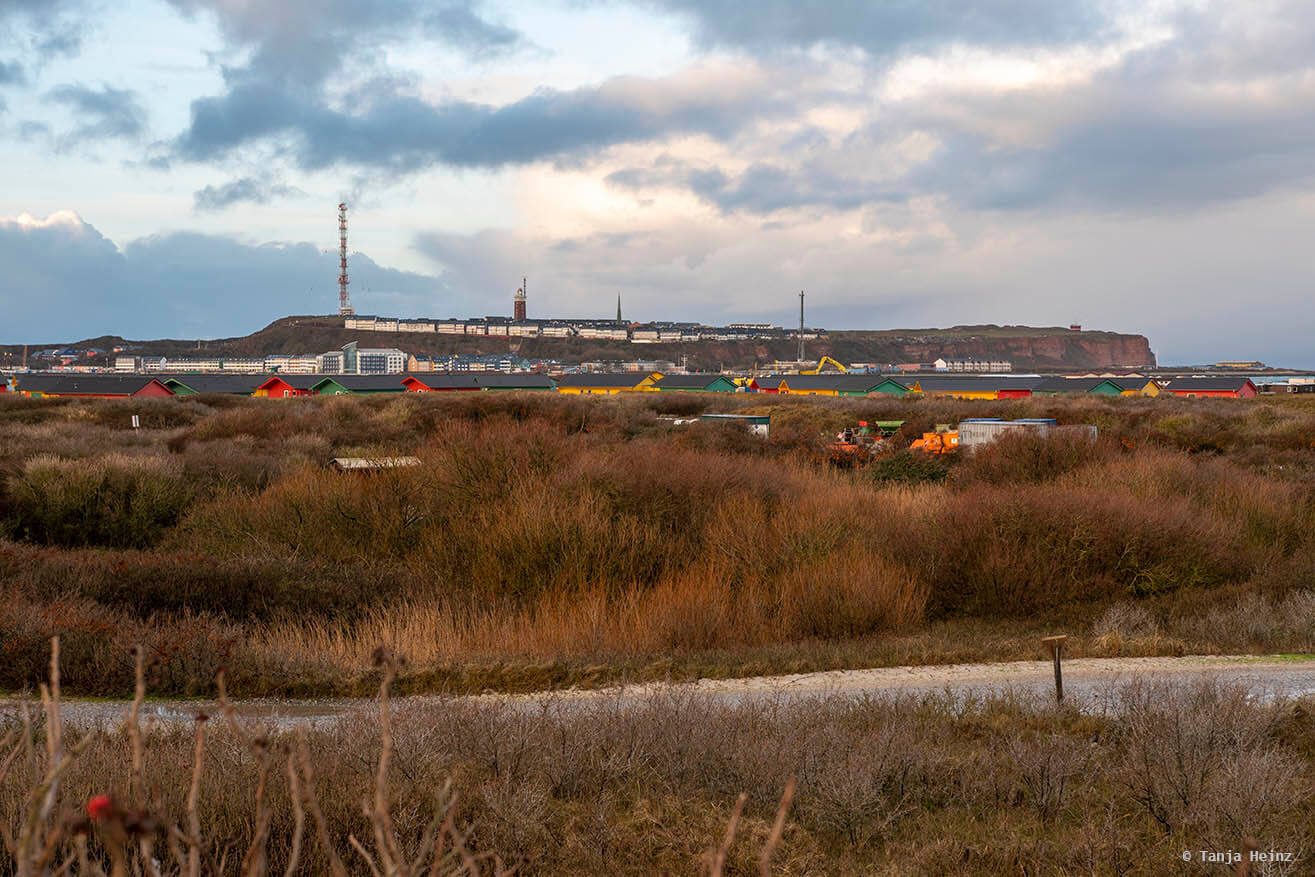
The Düne is very small. With a length of only about 1000 meters and a width of more or less 700 meters, distances between places are not far away. Apparently, the Düne is a popular place in summer to take a bath in the North Sea. In general, the sea at the Südstrand is calmer than at the Nordstrand, and thus, ideal for families with children. However, in summer you have to share the beach on the Nordstrand with sun-bathing common seals.
On the day of my visit I did not really know where to find the grey seals. Fortunately, a friendly person of the staff on the Düne told me where to go. Most grey seals could be found on the Nordstrand, and thus, I was heading into that direction passing the small airport on the right. You have to watch out for access paths to the Nordstrand.
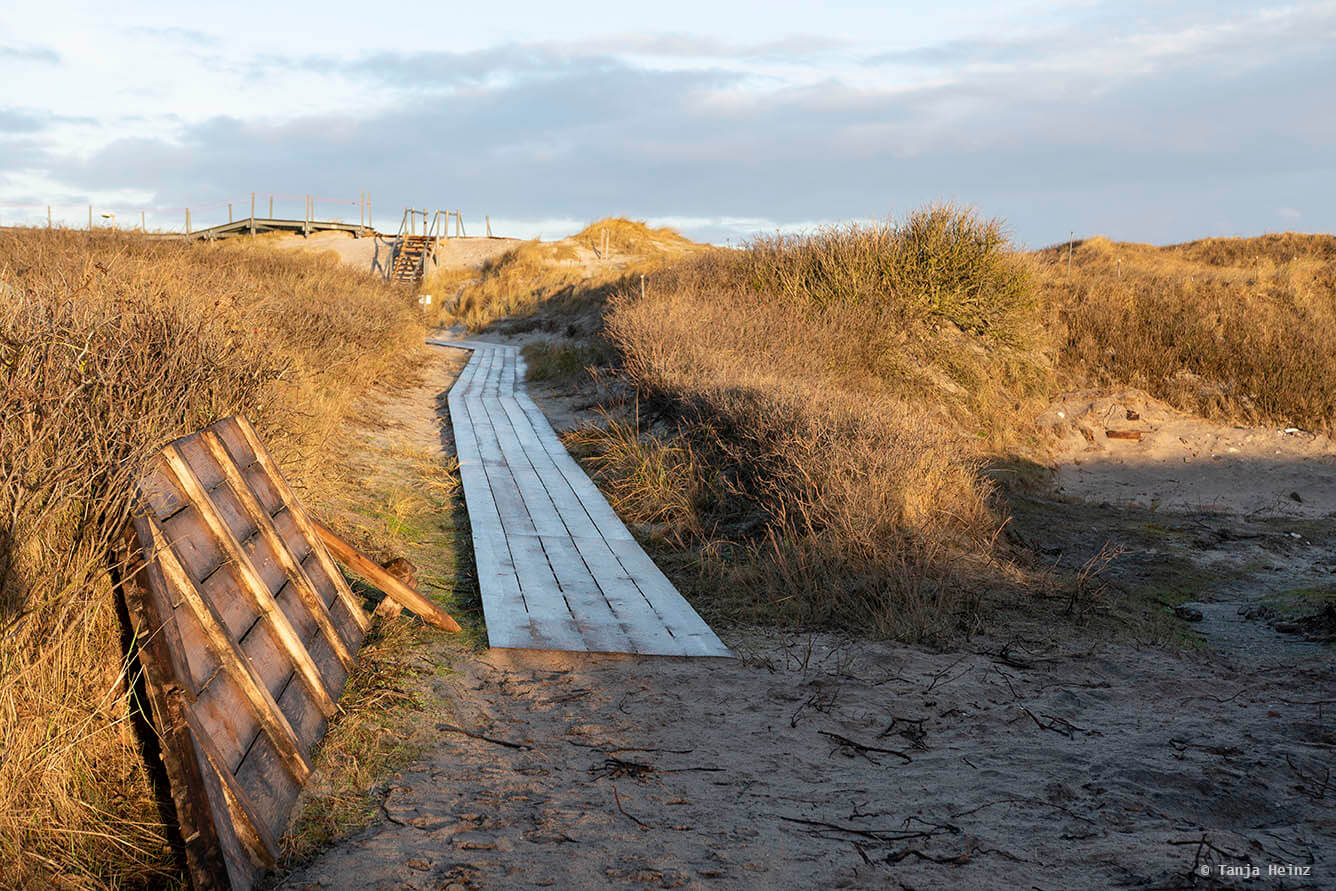
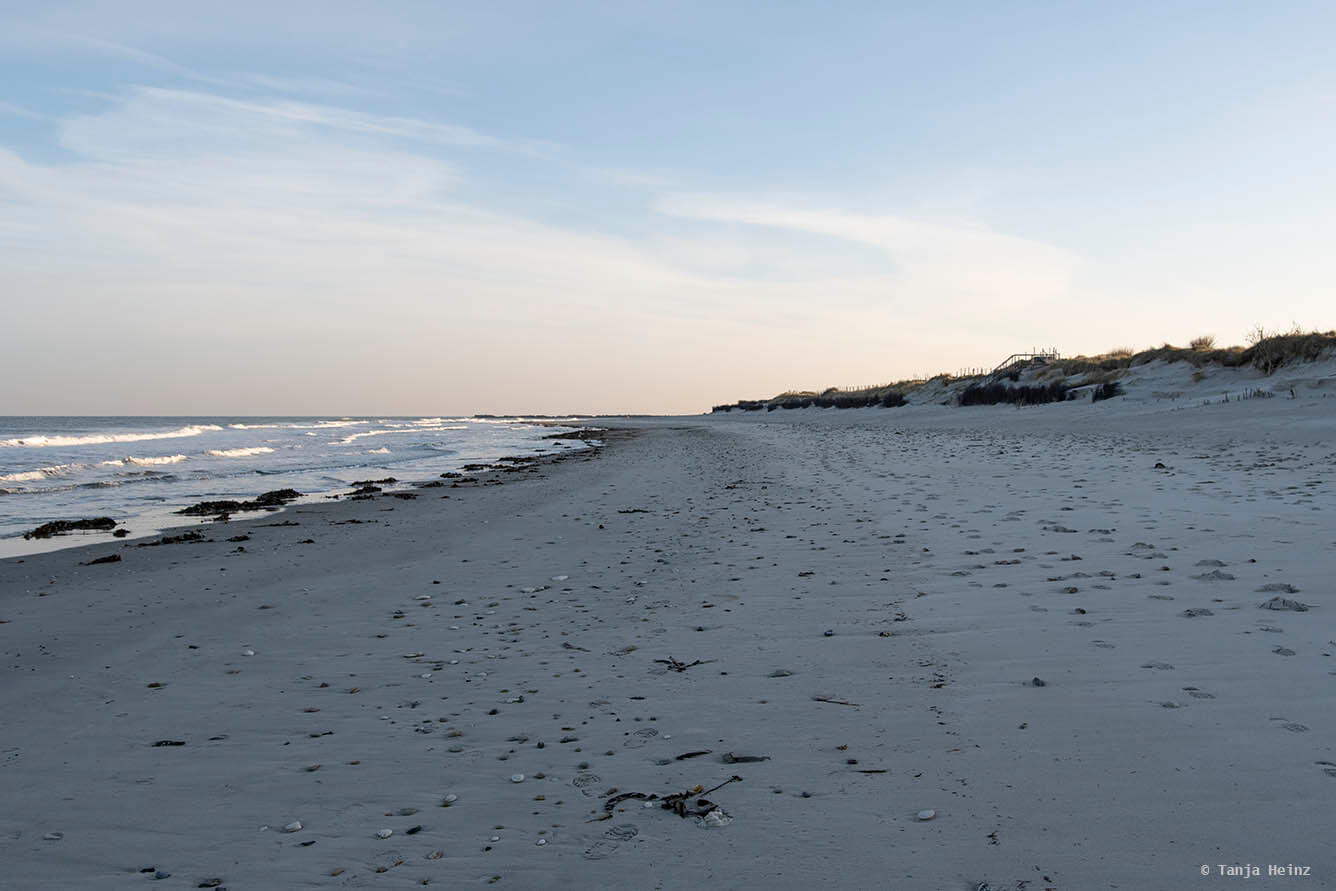
In general, the island is very quiet early in the morning. I took the first ferry to the Düne and felt almost all by myself (although I was not the only visitor that early in the morning). During midday and especially in the early afternoon more and more people filled the island (but it did not feel overcrowded...).
In the next paragraph, finally, I will tell you more about the grey seals and why many people - especially wildlife photographers - visit the Düne of Heligoland in winter.
Tip: In winter it can be quite cold on the Düne. Although it was sunny most of the time, the air can be very freezing. If you want to stay for several hours on the Düne, there is a restaurant or café in the airport building where you can warm up with a hot tea or something else.
Grey seals on the Düne
The first thing I have to mention here, grey seals are very photogenic and I really (really!) enjoyed photographing these animals. I took thousands of photographs from which it took me hours to select the best ones. This was indeed not an easy task. Therefore, I hope you do not feel overwhelmed with all the photographs I present in this blog entry. I just want to give you some photographic impressions of grey seals.
With their beautiful big eyes, I’m sure grey seals make every heart melt. At least it was in my case.
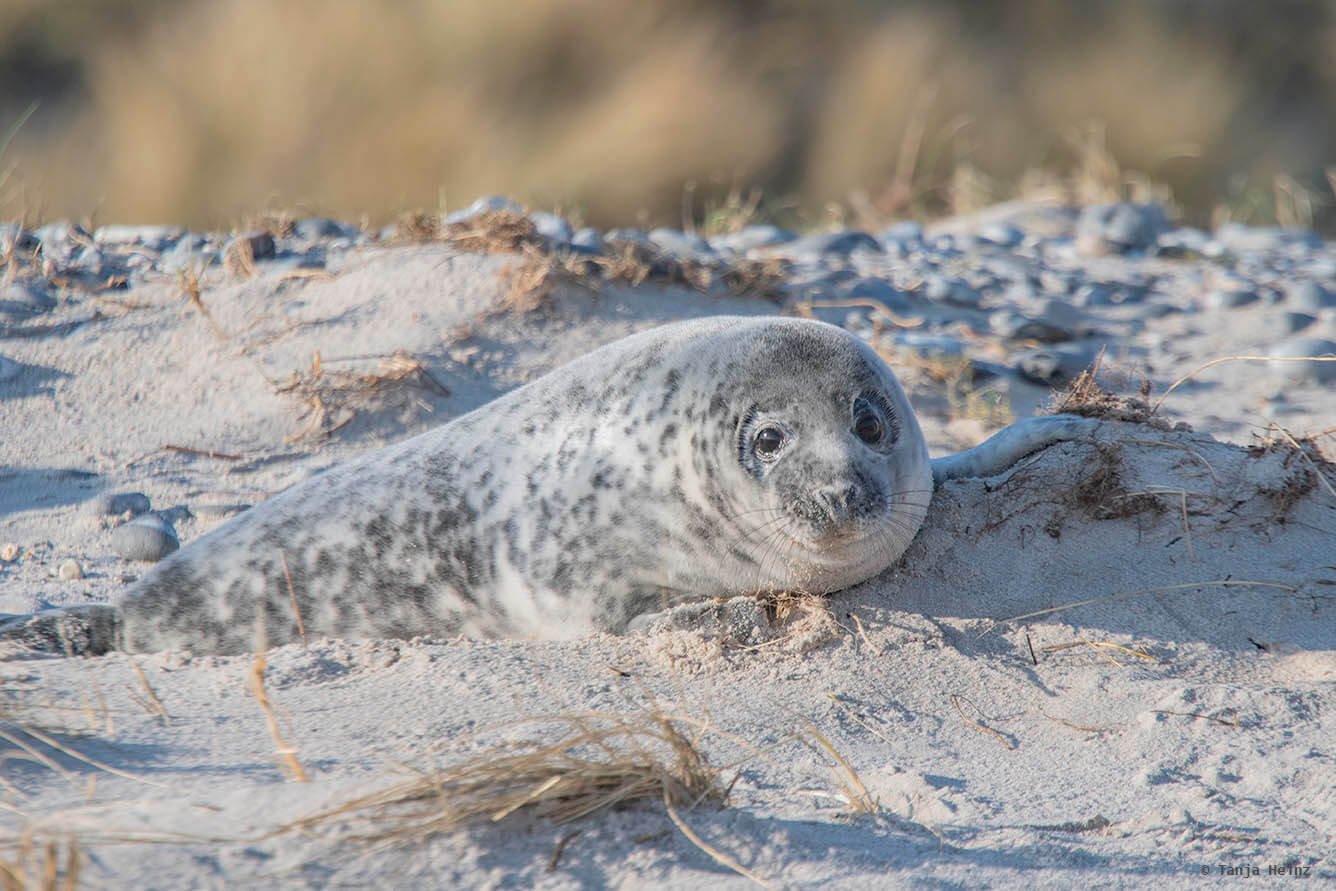
Nevertheless, there was one reason why I decided to visit Heligoland in winter and not in summer: the cubbing season of grey seals from November to January. Every year in winter, female grey seals come to the beach of the Düne to give birth to a young with a soft silky white fur which will change after two to four weeks. I was on the Düne in mid-January, and thus, already at the end of the season. Luckily, just two days before my visit, a mom gave birth to a young. I just had to search for them.
I saw a white fluffy pup on the beach on my first morning on the Düne, probably waiting for its mom to come back.
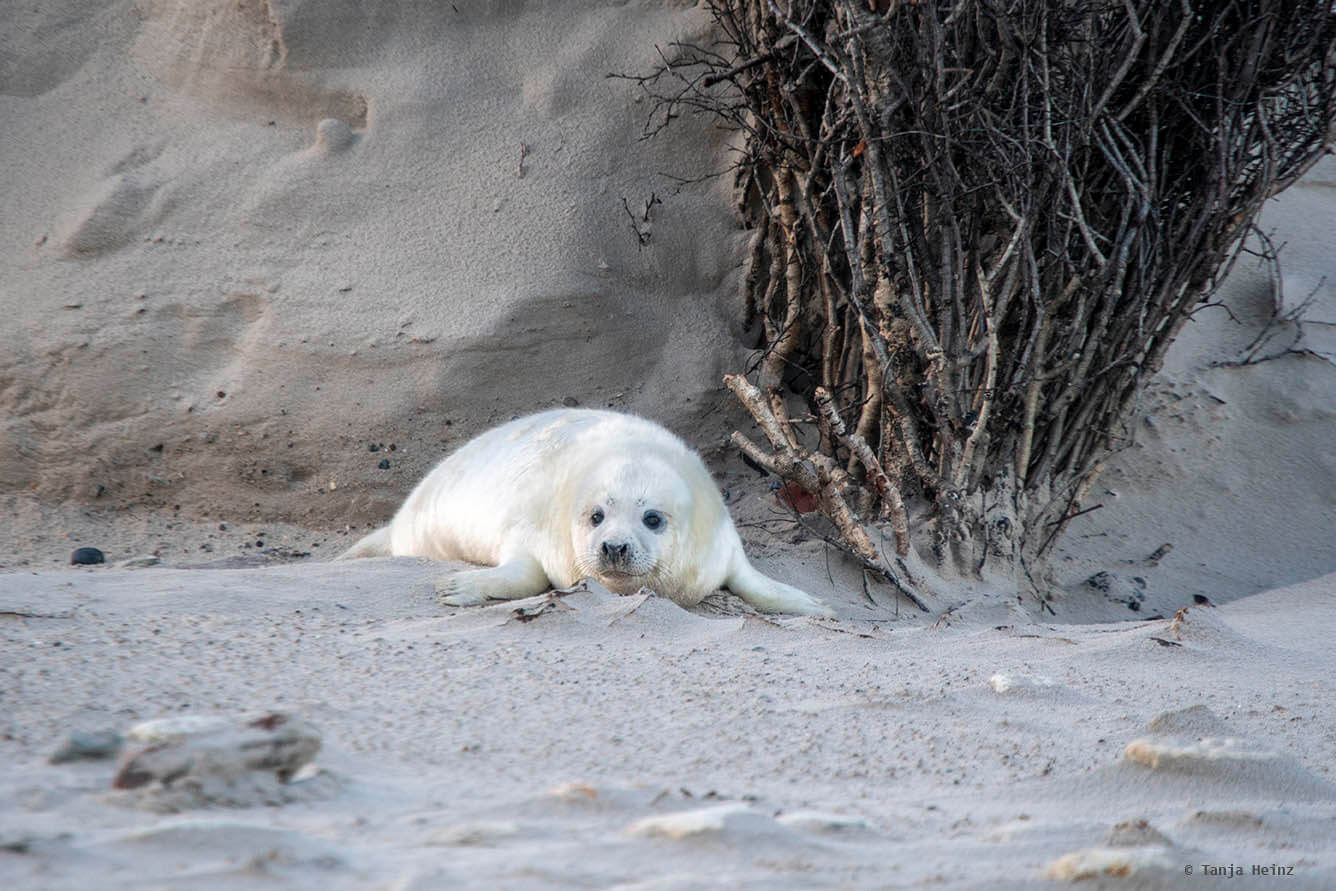
It was not the most recent newborn on the Düne. But where was its mom? I couldn’t see her close-by. I was looking to the sea, but instead, I saw some other grey seals playing around with each other.
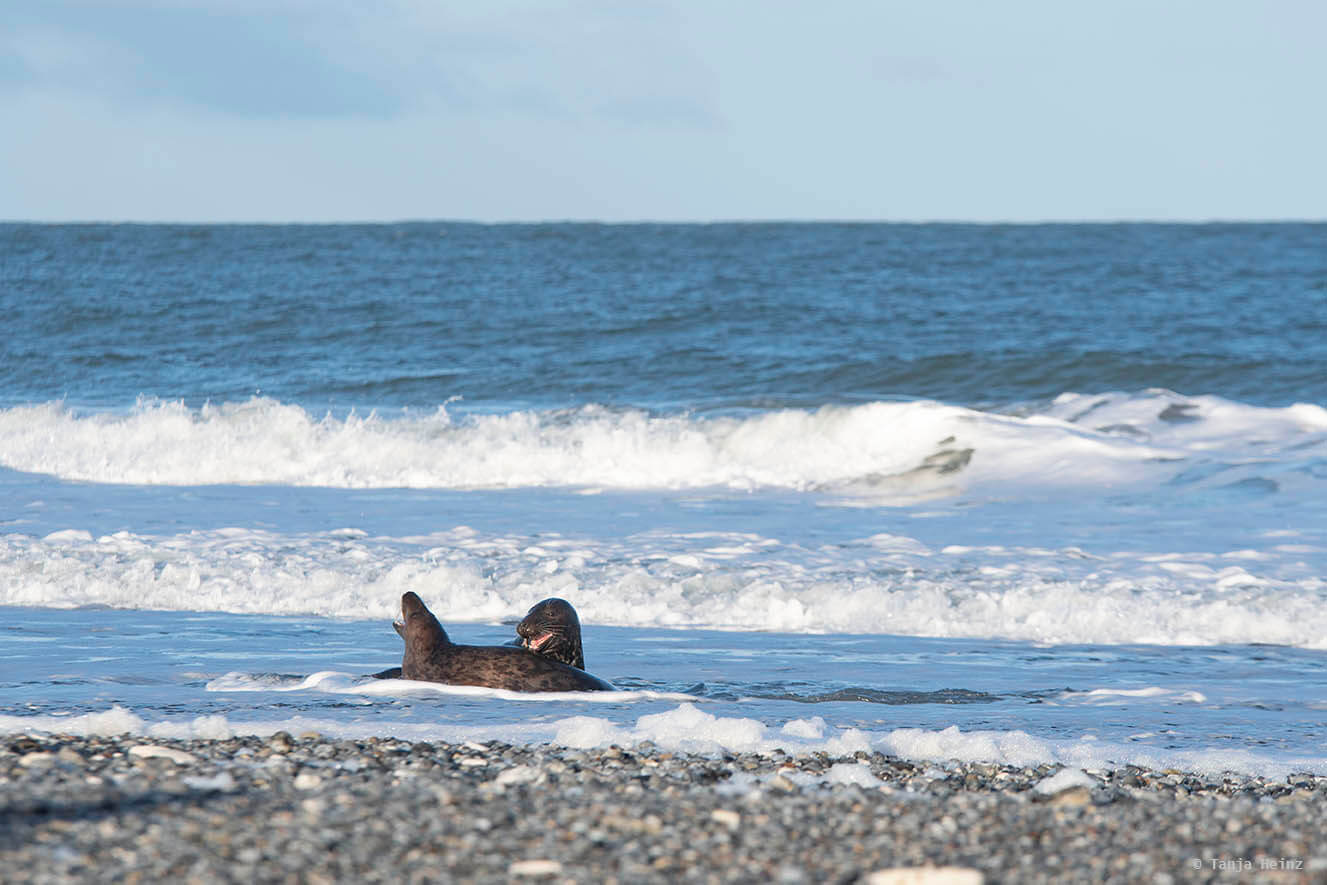
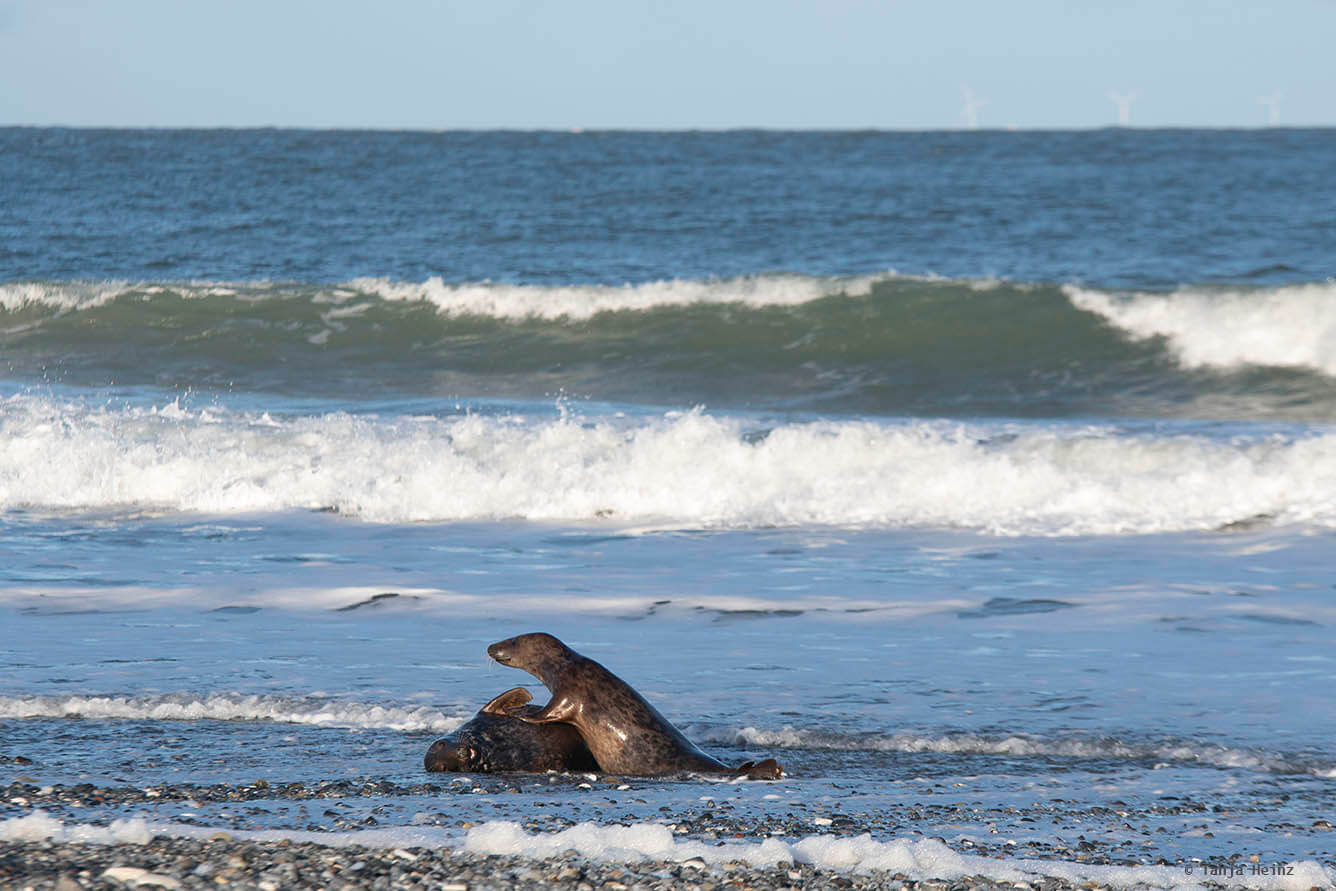
It was very amusing observing these two grey seals. I sat down on the rocky beach and took my time to watch them play. Who was stronger? Is this a way to prepare for adulthood among grey seals? I just could guess. But according to their sizes and their playful behavior they seemed to be rather still juveniles.
Nevertheless, after some time I decided to get up and go ahead to see other grey seals. I came across a mom and its pup, but it was not the newly born one, neither. Both relaxed on the beach, apparently (or better: hopefully) not disturbed by my presence.
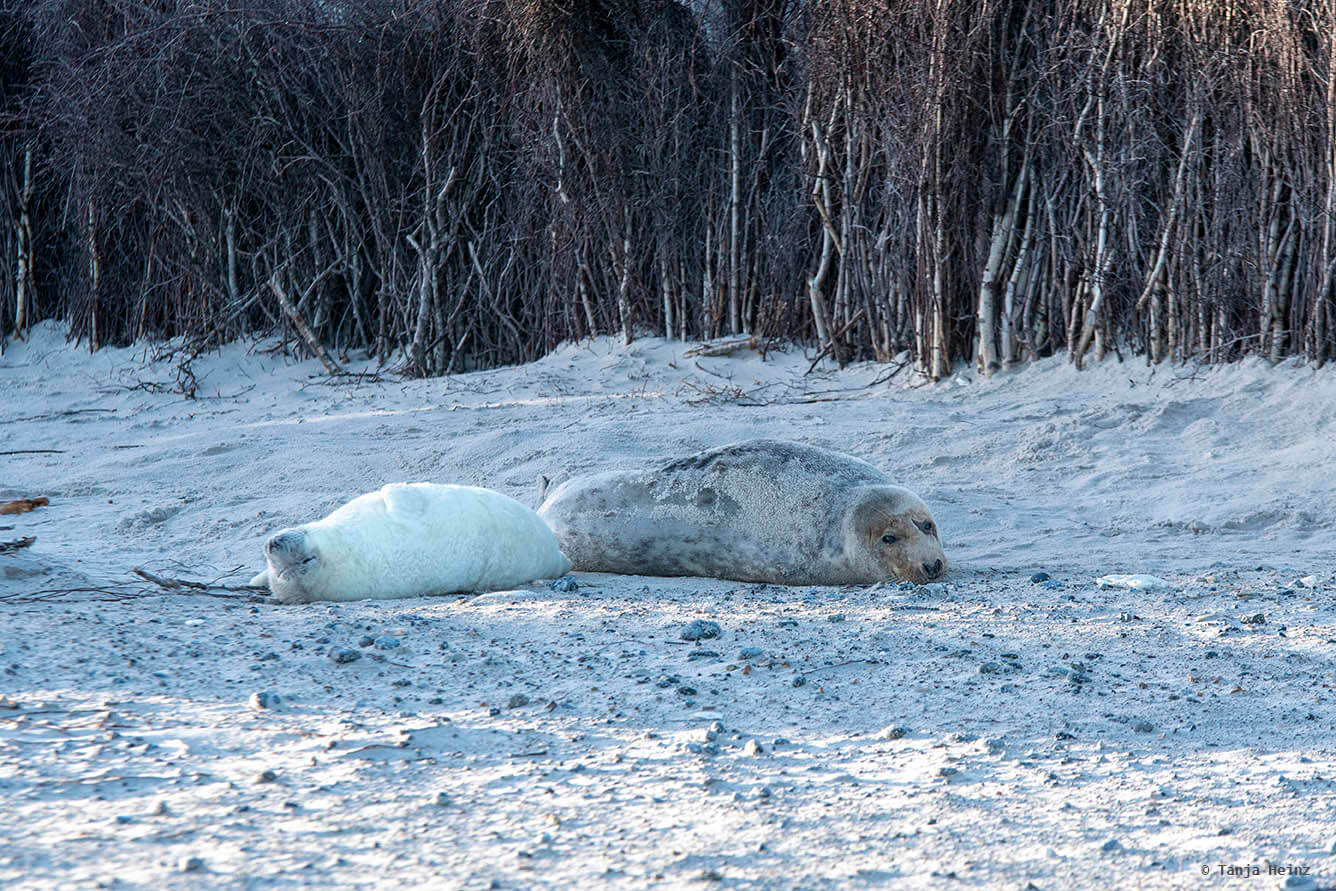
Did you know? There are two nature reserves on Heligoland. On one hand there is the "Lummenfelsen" (Lummen: "guillemonts", Felsen: "cliffs") - where several sea birds brood in spring and summer. And on the other hand there is the "Helgoländer Felssockel" which is a marine nature reserve in the north of the main island. The "Helgoländer Felssockel" extends to the "Helgoländer Düne".
As time passed, more and more people arrived on the Düne. Especially photographers interested in getting good photographs of grey seals. The Düne was not crowded, but I never would have thought that so many people came with their big cameras to Heligoland. However, if you want to photograph or see grey seals, you have to follow the rule not to approach these animals. You have to keep a distance of at least 30 meters.
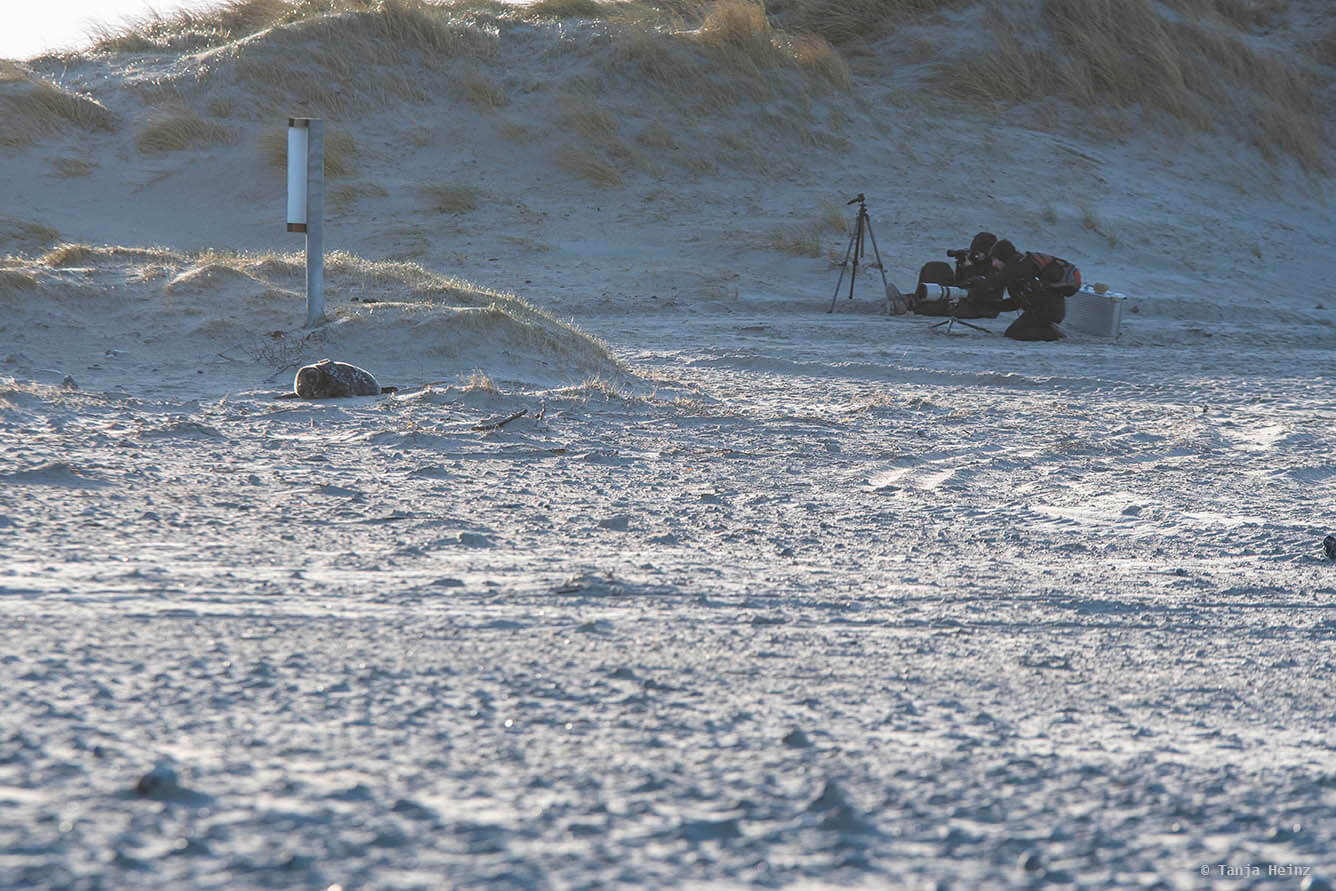
I was talking with a volunteer of the organization Jordsand. They pointed the visitors to the rule of keeping a distance to the grey seals. I imagine this is not an easy task and probably also kind of frustrating when people do not keep the rule and you always have to remember them. Therefore, if you want to photograph grey seals, remember to bring lenses with a long focal length with you. Don't approach the animals for a good photograph!
One of my favorite place on the Düne was located on the north east, as there were quite many grey seals around.
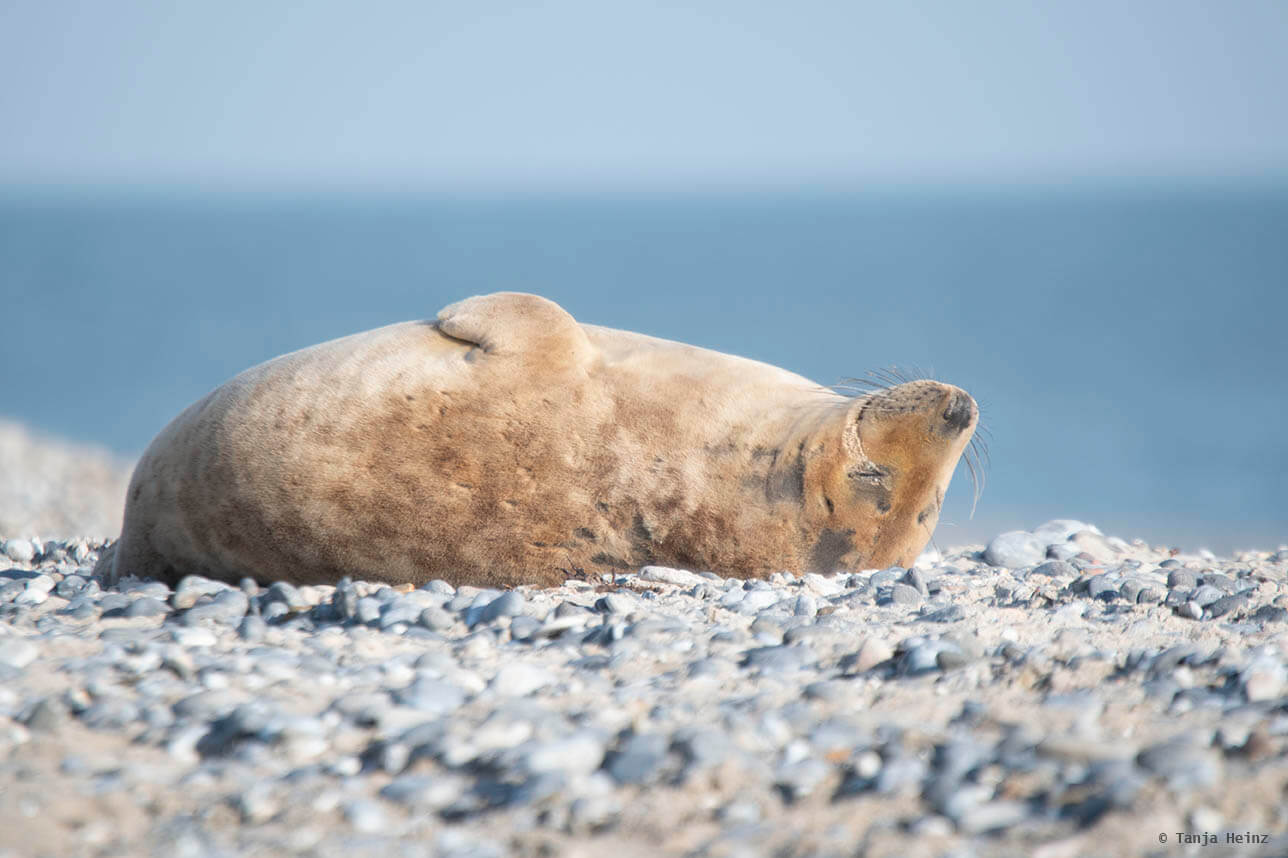
Some were moving. Sometimes showing the funniest postures.
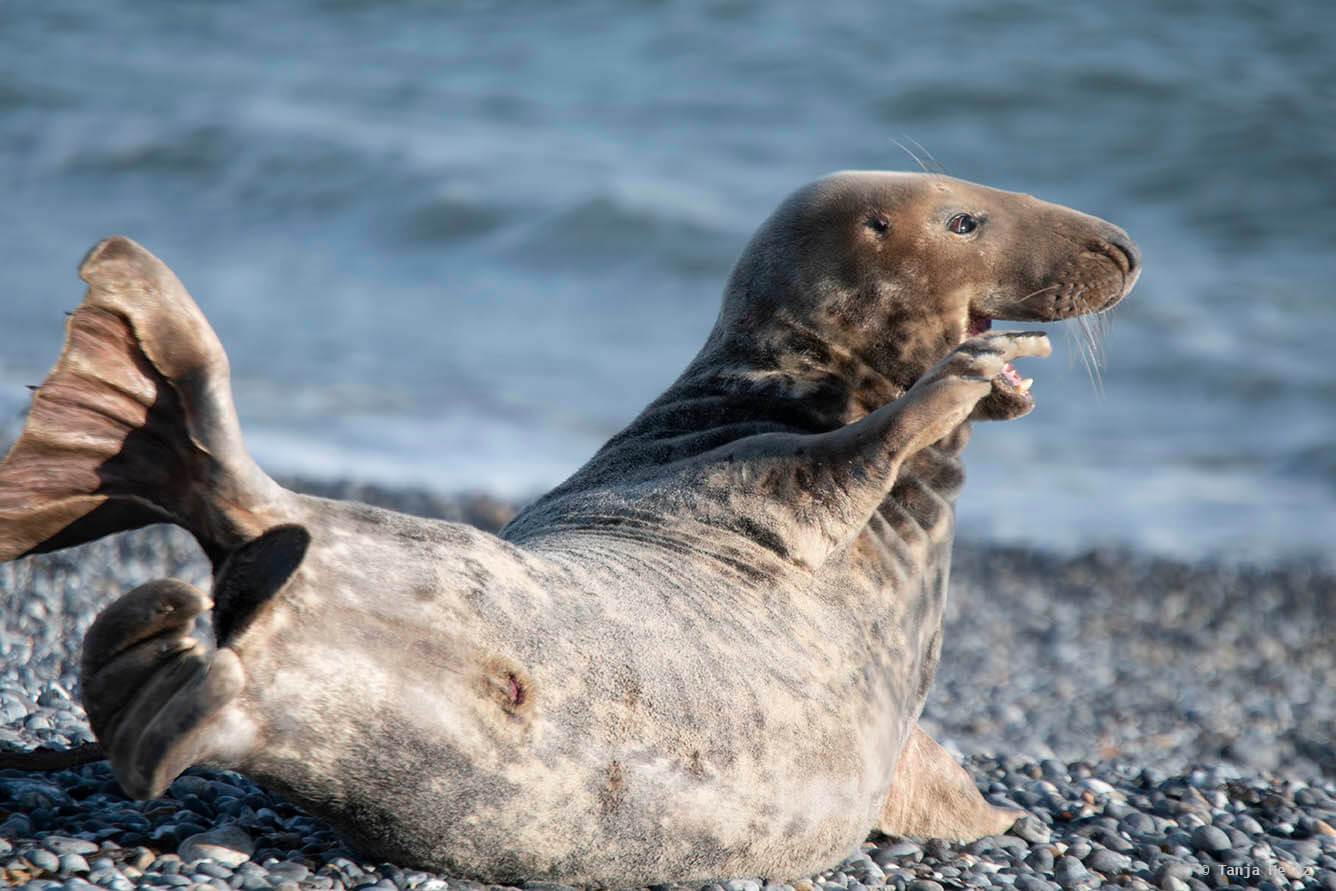
On all three days I spent most time close to this spot. Although most grey seals were sleeping, there I observed the most interesting sleeping postures.
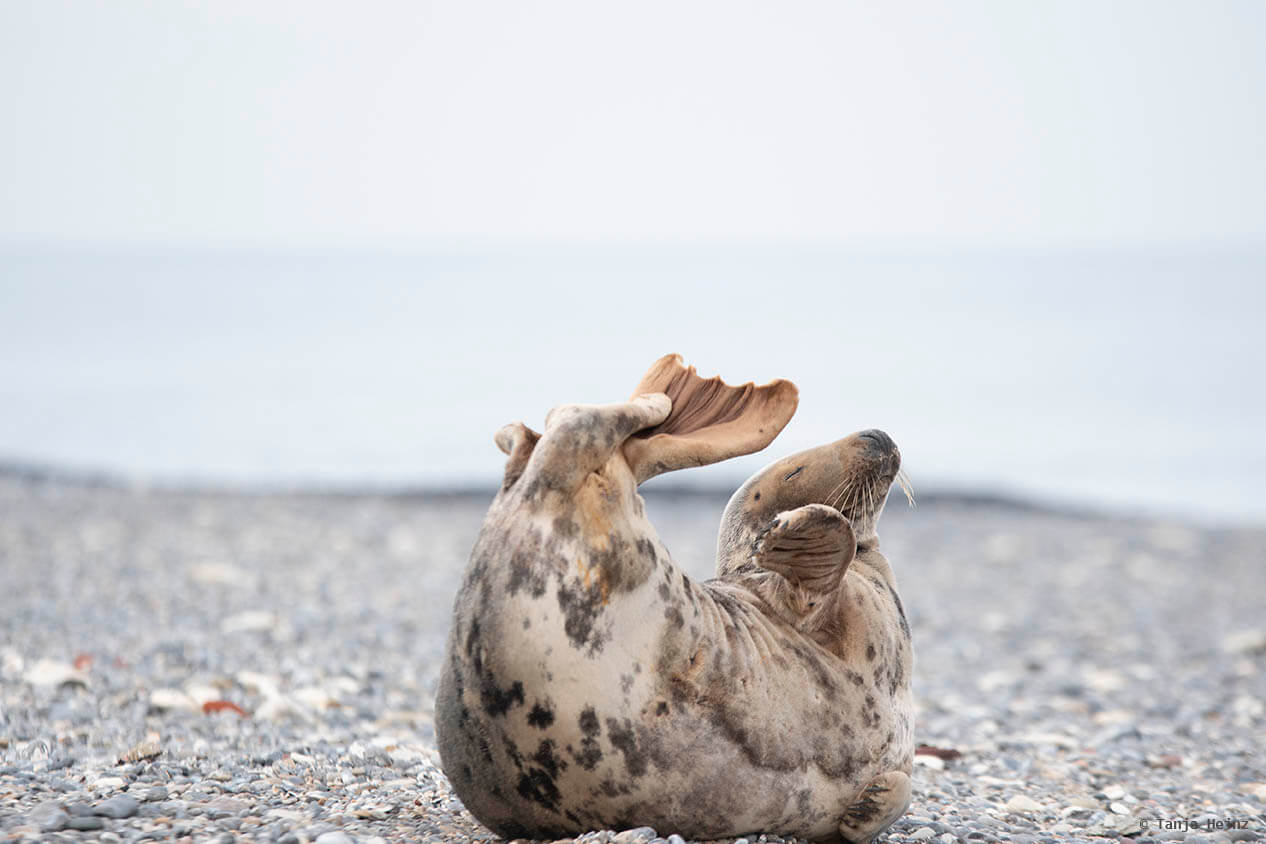

I also observed some grey seals with injuries. I guess they came from fights with each other, as after cubbing season the breeding season begins. Grey seals do not defend a territory, but they defend a female against other males for mating. I observed one male even with a damaged eye.
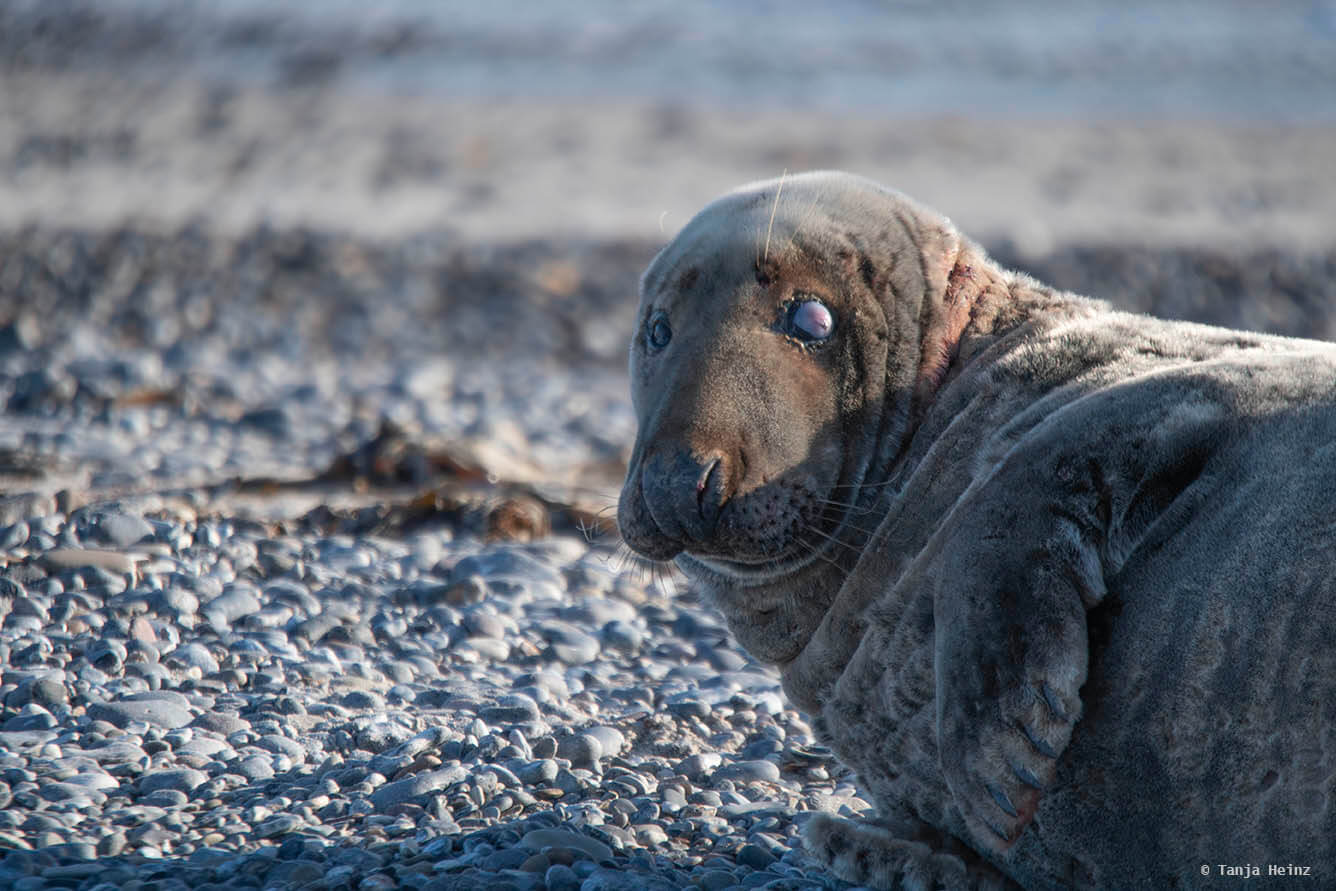
Another individual had some bite marks just below its head.
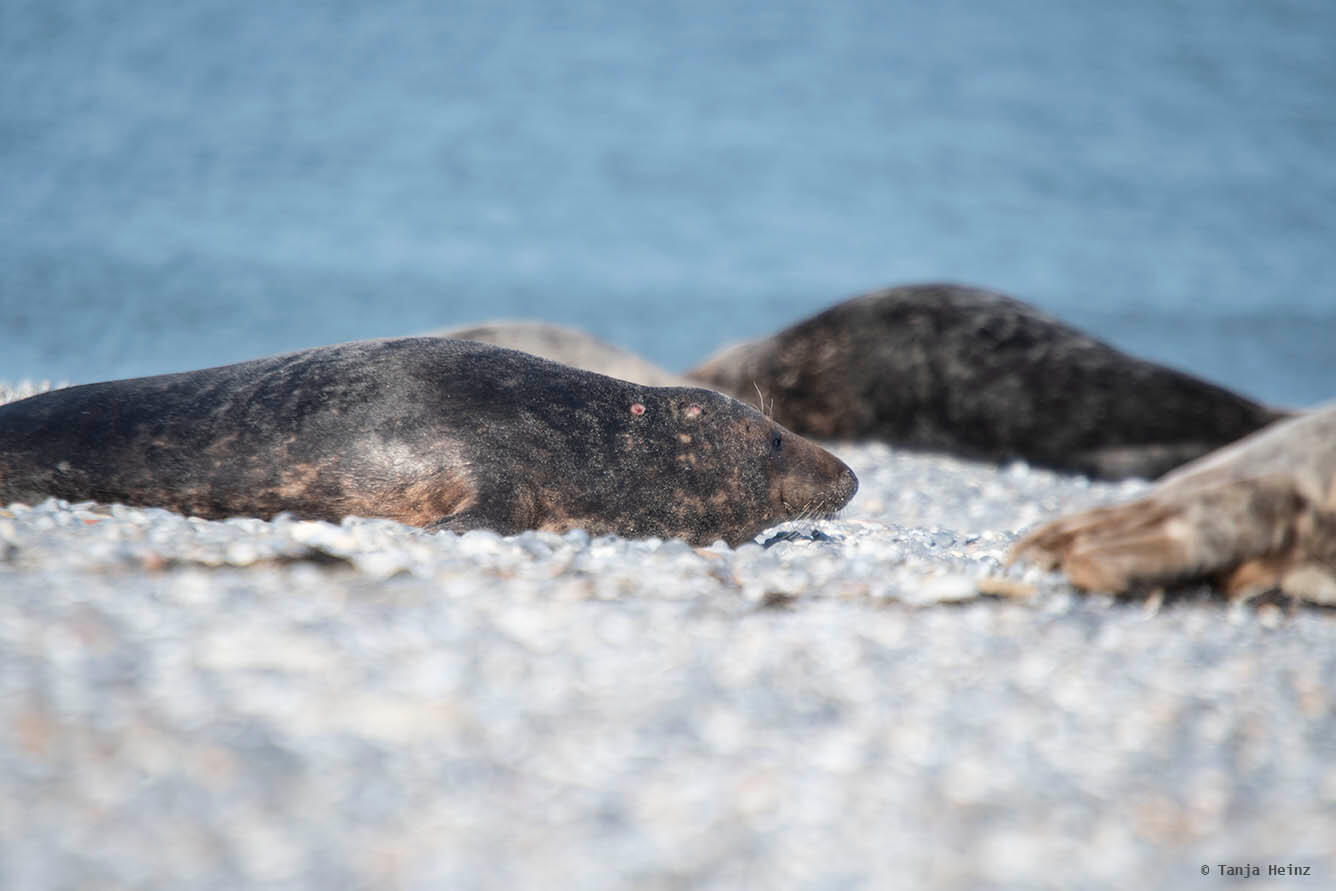
Important: Bear in mind that grey seals are carnivores with a powerful bite. I saw quite many males on the beach with injuries. Be careful and stay away. By all means, never touch a grey seal! If you feed the animals, a fine will be the consequence for you!
Usually, if you want to see something interesting on the Düne, sometimes you just have to look around and watch out for groups of people. I actually do not like gatherings of people, especially when wild animals are involved. However, apparently it is better to approach grey seals as a group and not as a only person, as there would be to much traffic around the animals. Anyway, I could already imagine why they probably had stopped at this place. A mom grey seal with a newly born pup. And indeed, I was right with my assumption. A mom was lying just next to its young. Behind them a male.
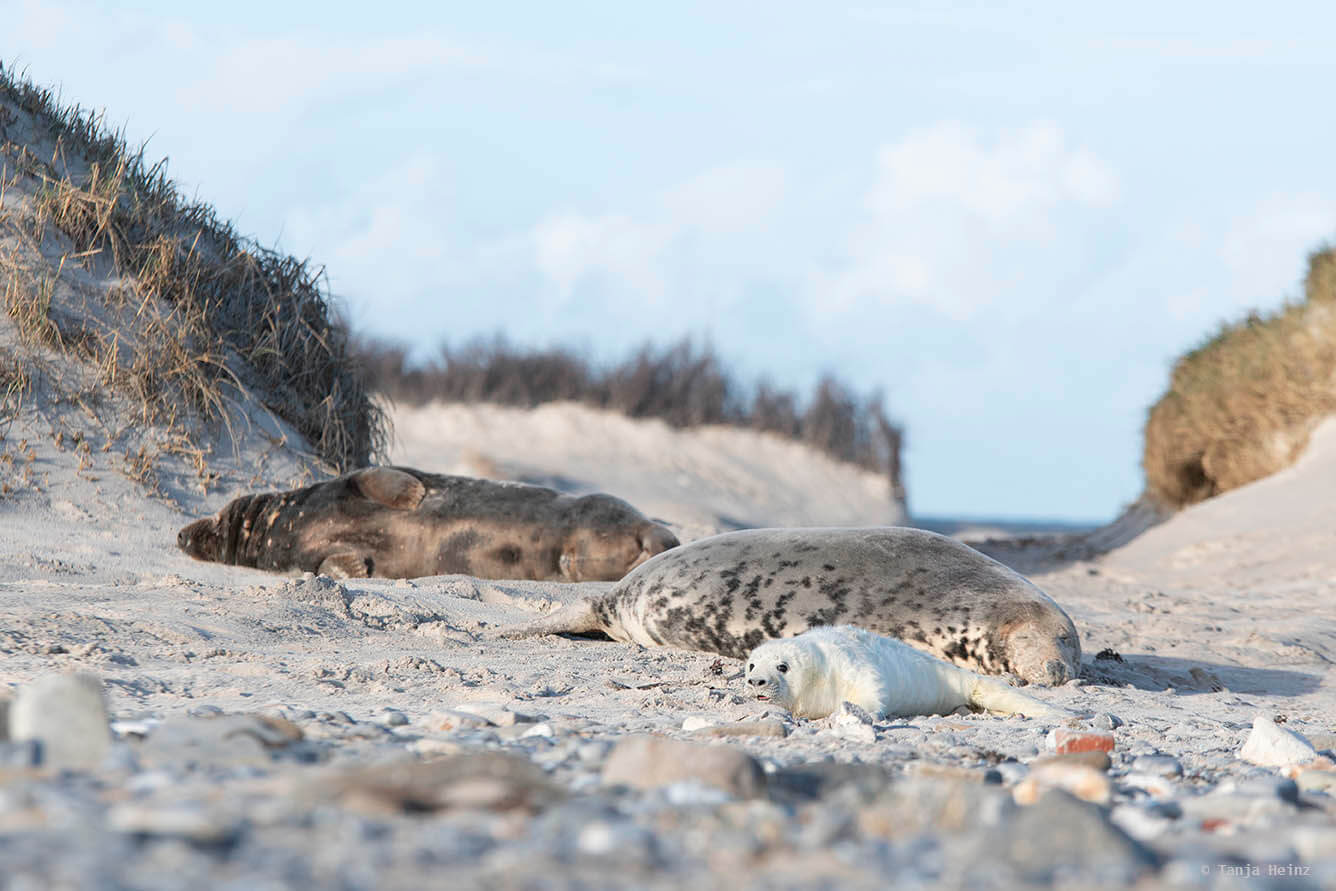
Although a male was around them, males do not provide any parental care. But why was he sleeping so close to the mom and its pup? Was it just a coincidence? Or did he provide some protection? As males might mate with up to ten females, he might be a potential father? I do not know it. I rather guess, that this male might have waited for the young to be weaned, as the breeding season follows the cubbing season.
The three grey seals were sleeping on an elevation. Thus, observers could hide themselves a little bit and avoid being fully seen by them. Observing this mom and its young was so... heart-melting and very moving. The mom was gently touching the pup looking as if it would happily smile.
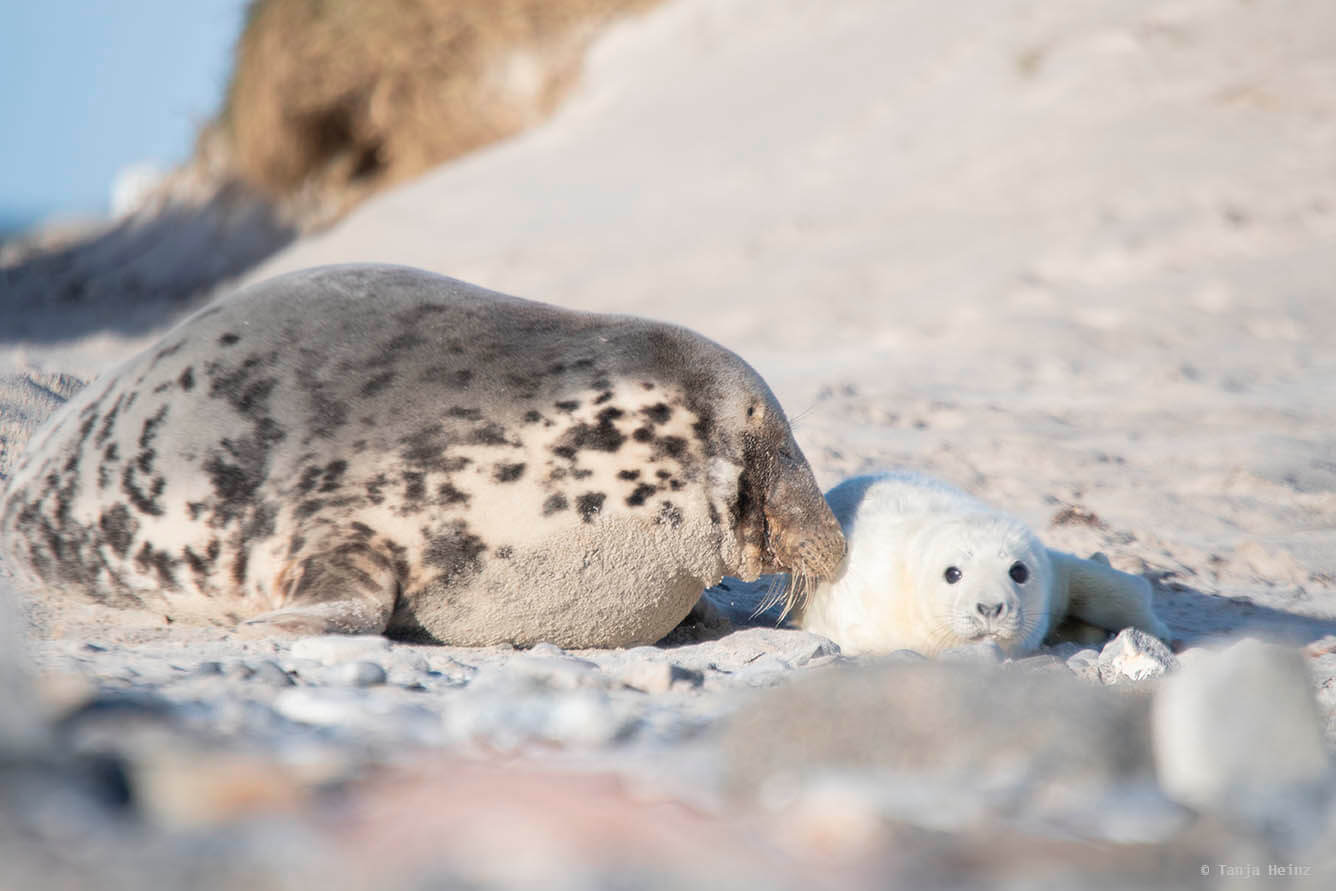
It was so special, but I did not stay for such a long time around them. They were sleeping and probably exhausted after birth. In one moment, the young was moving and I even could sea its umbilical cord still attached.
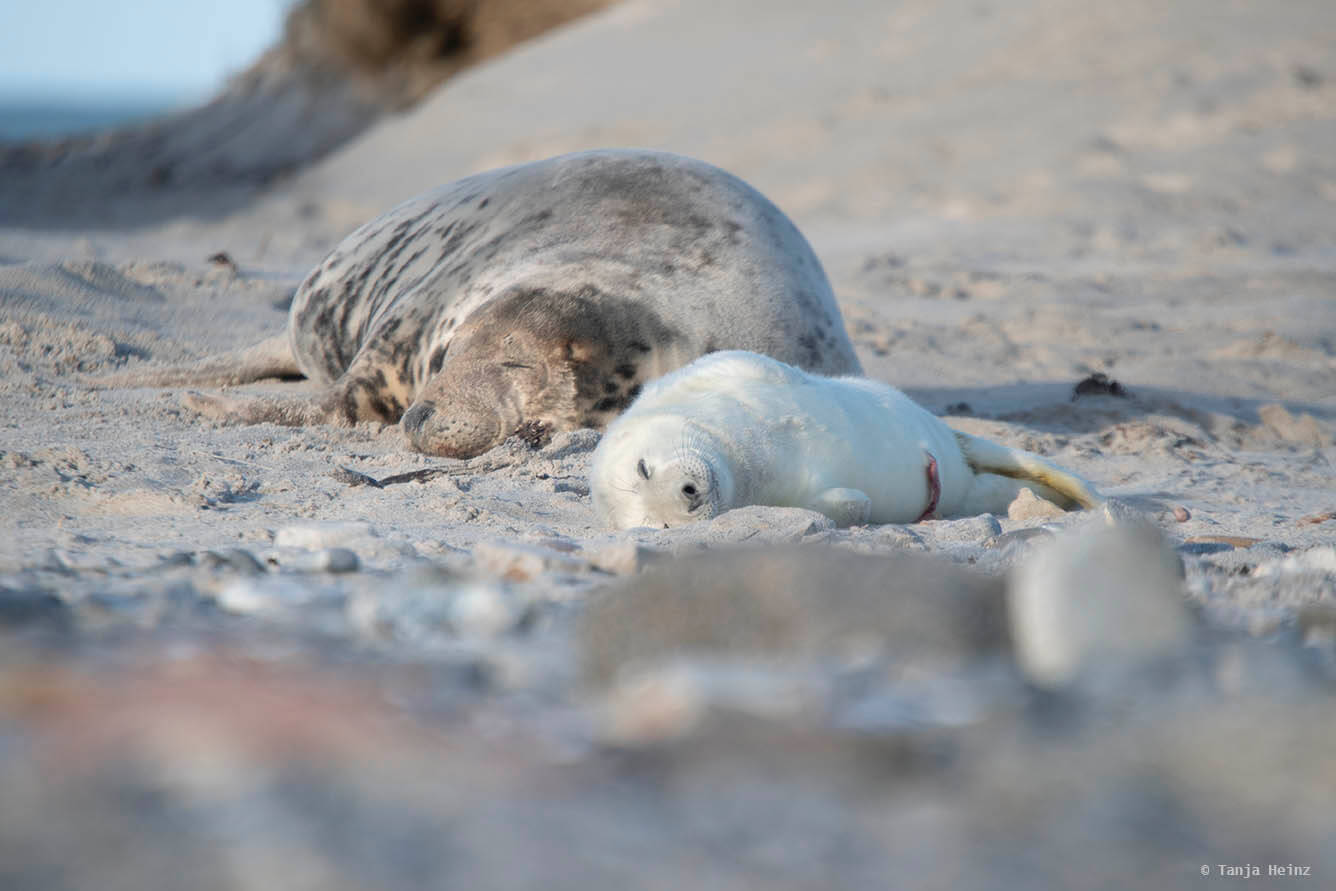
On all three days I passed the place of the newly born grey seal. On the second day I observed the mom how she moved towards the sea.
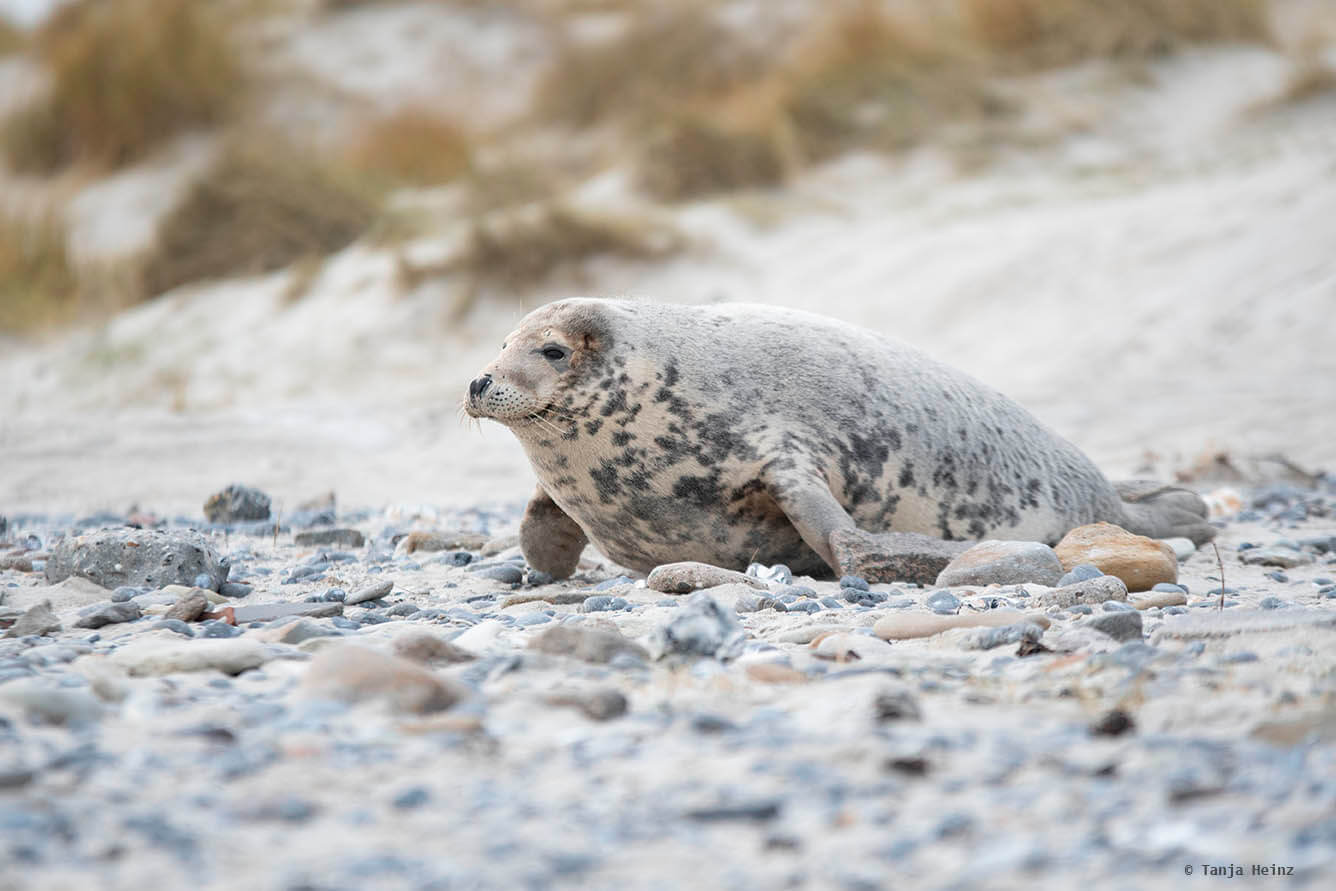
She left its young back on the beach, but she had to come back to lactate it, as the cub couldn't swim with its fur yet. Grey seals first have to grow a dense waterproof adult fur before they can leave the beach to fish for themselves in the sea.
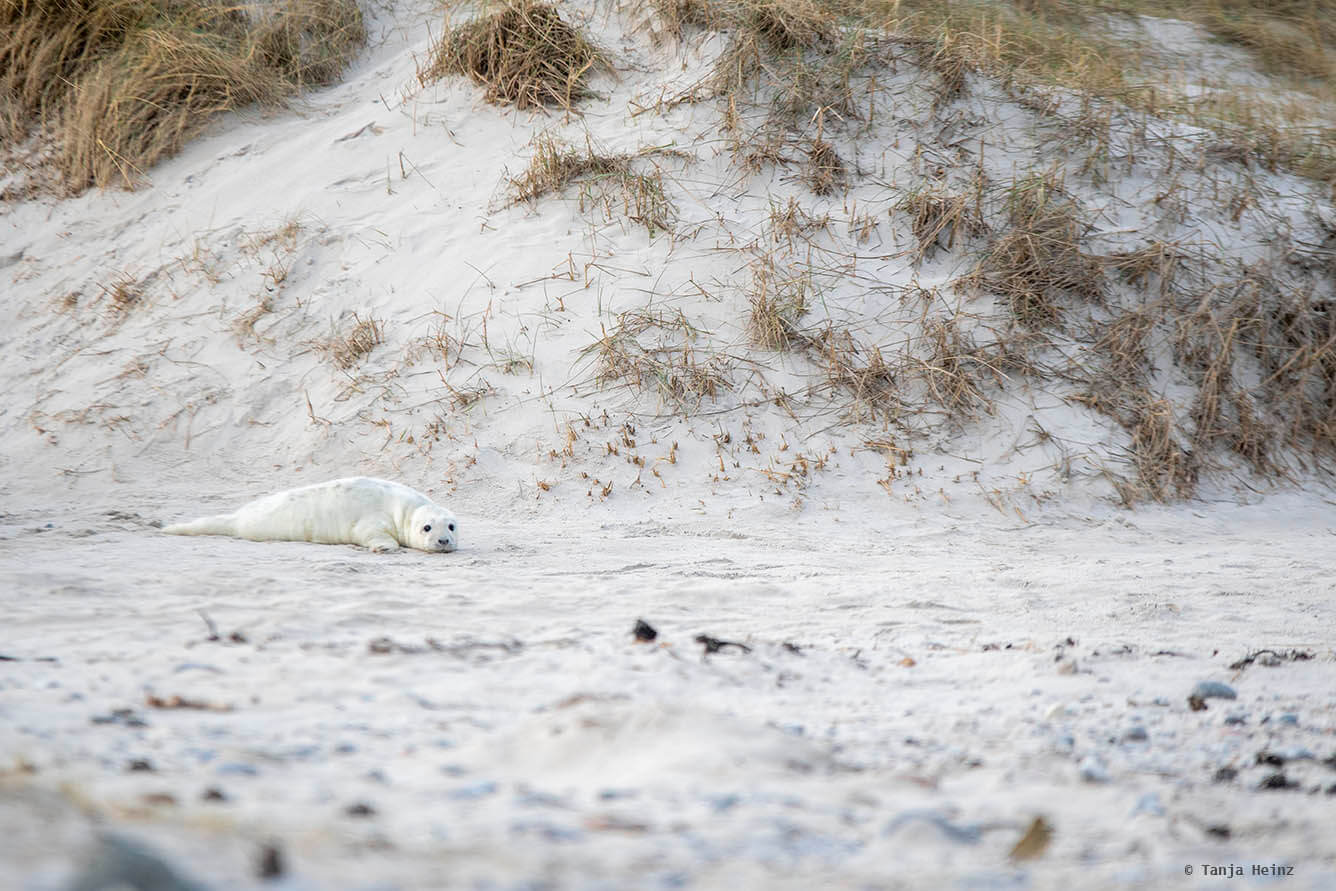
Interesting: In 2020 the association Jordsand could count 530 newborn grey seals for the 2019/2020 birth season. The first babies were counted in November. Please check the website of Jordsand for more information.
As I strolled around the Düne I observed all kinds of different colored individuals. One was rather dark. Another one bright brown.
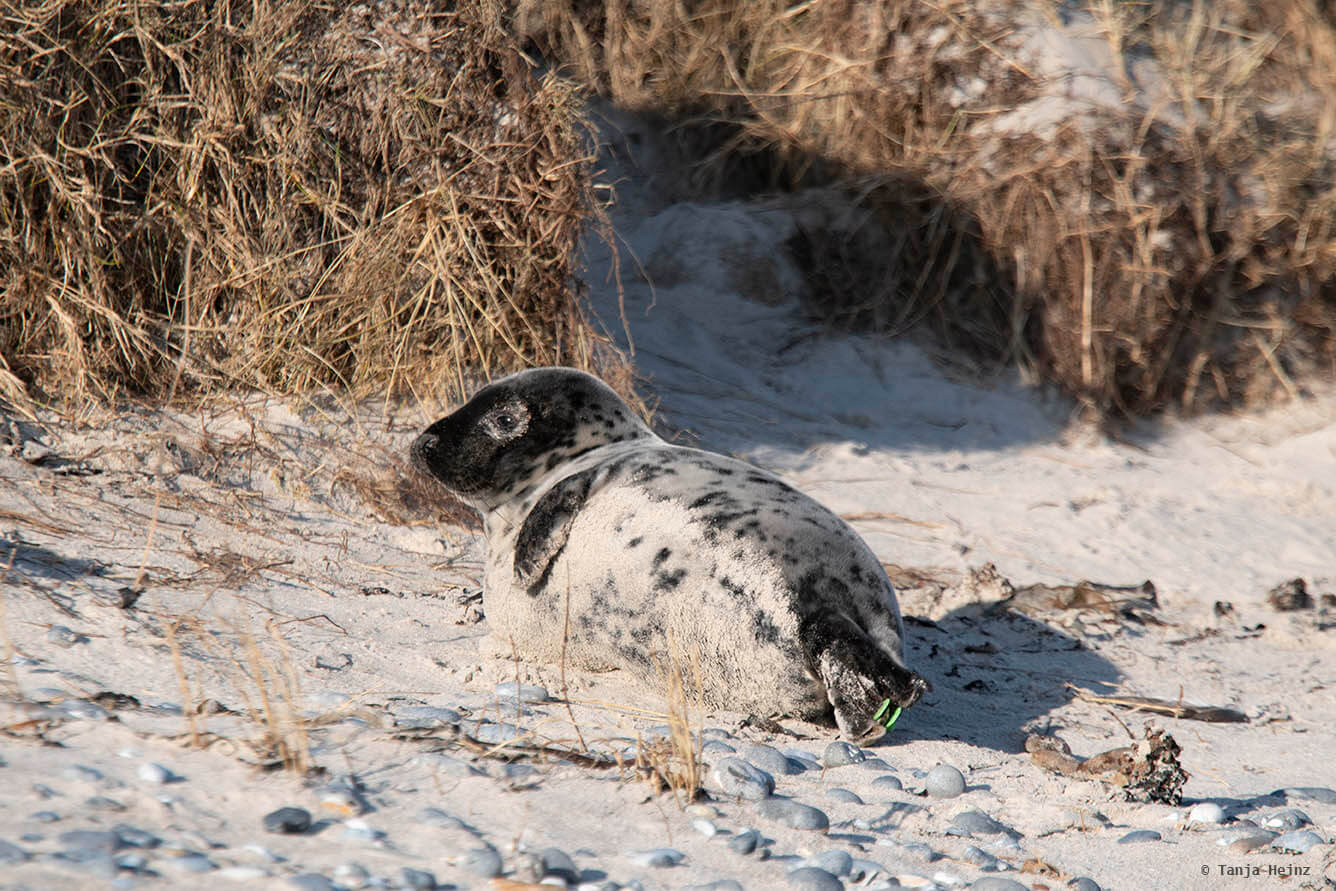
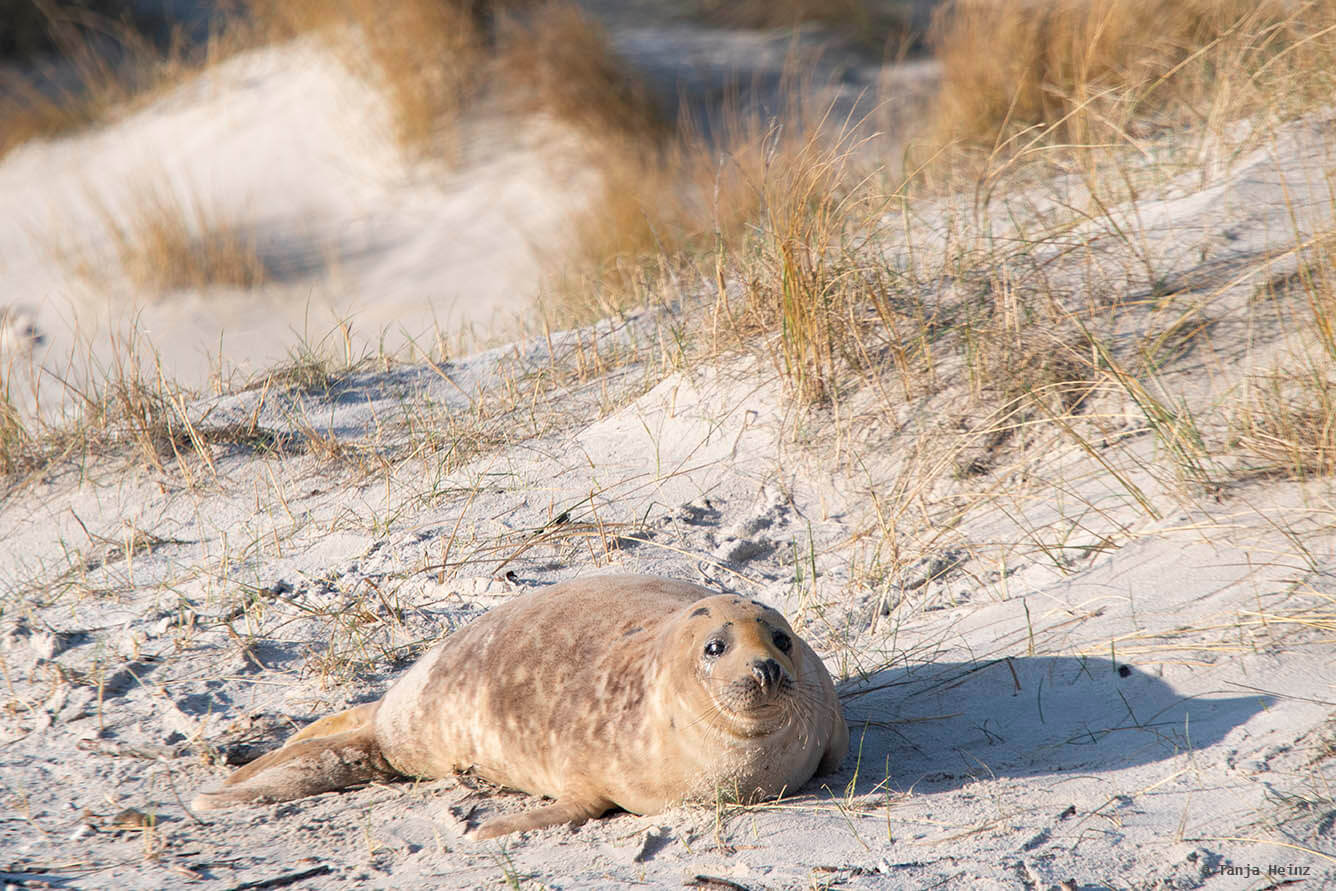
Some were bright grey.

And others rather dark brown.

Therefore, it is quite hard to describe the color of grey seals. In general it can be said that males are darker than females and young. There are even two more characteristics which can be used to distinguish females and males. These two characteristics are their sizes and muzzles. Males are larger than females and their muzzles broadens into a convex fleshy snout. Females do have a narrower head and a slightly convex muzzle.
Consequently, the following grey seals I saw playing in the east of the Düne were most probably two females.
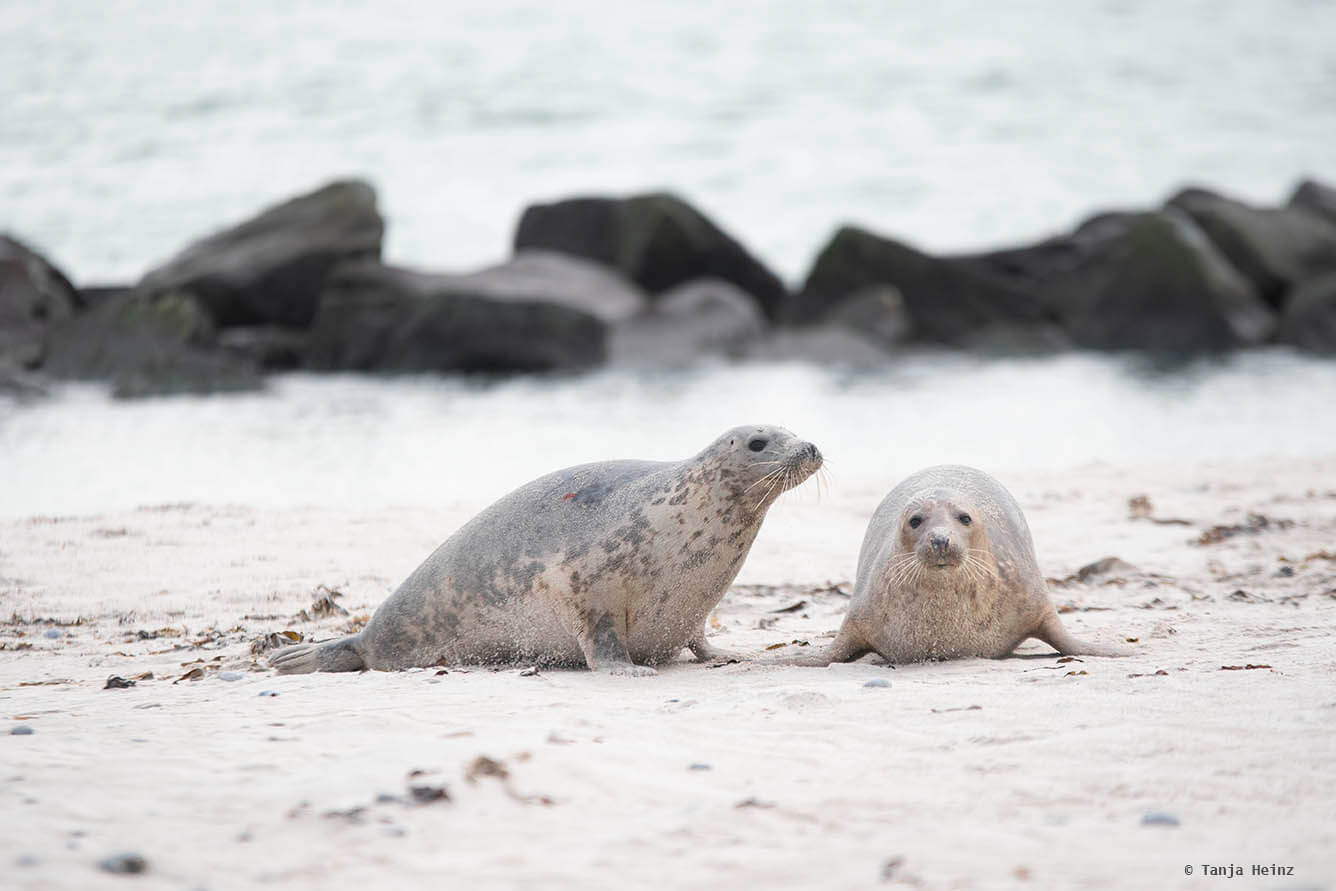
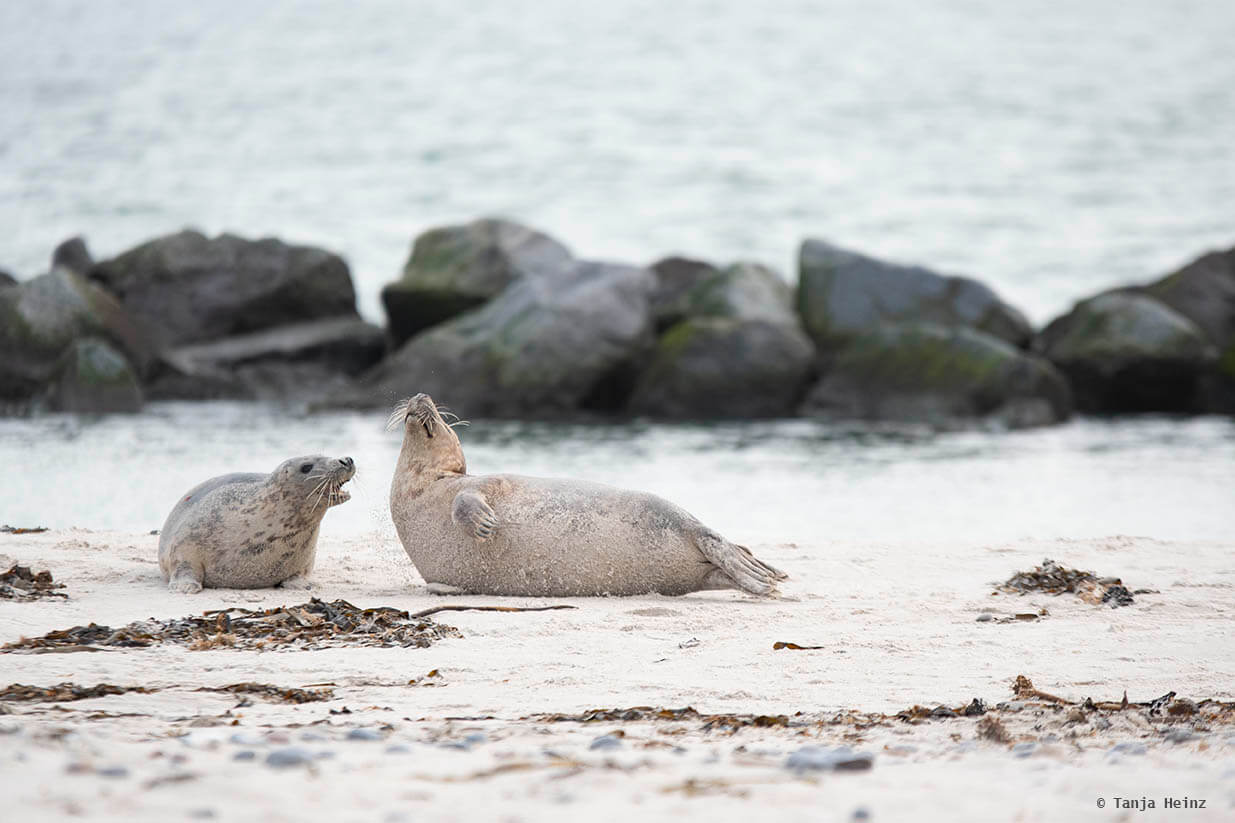
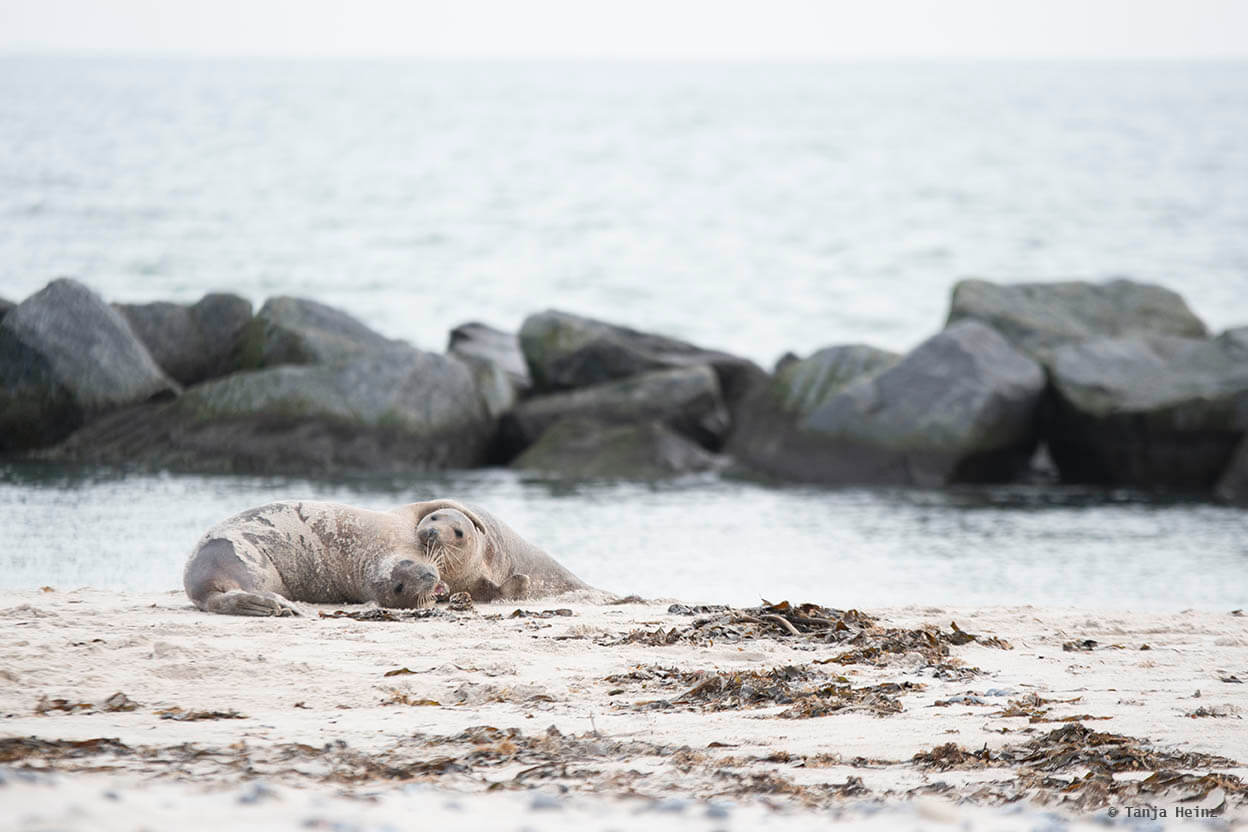
Apparently, they were not afraid of me at all, as they were moving into my direction. As I wanted to keep a 30 meters distance I had to leave.
The males were in general quite impressive. I wouldn’t have ventured to approach them too closely. Remember that grey seals are carnivores and fights happen between males. Therefore, it is even more important during the breeding season to keep a distance.

As I often saw males and females together, I could see the size difference.

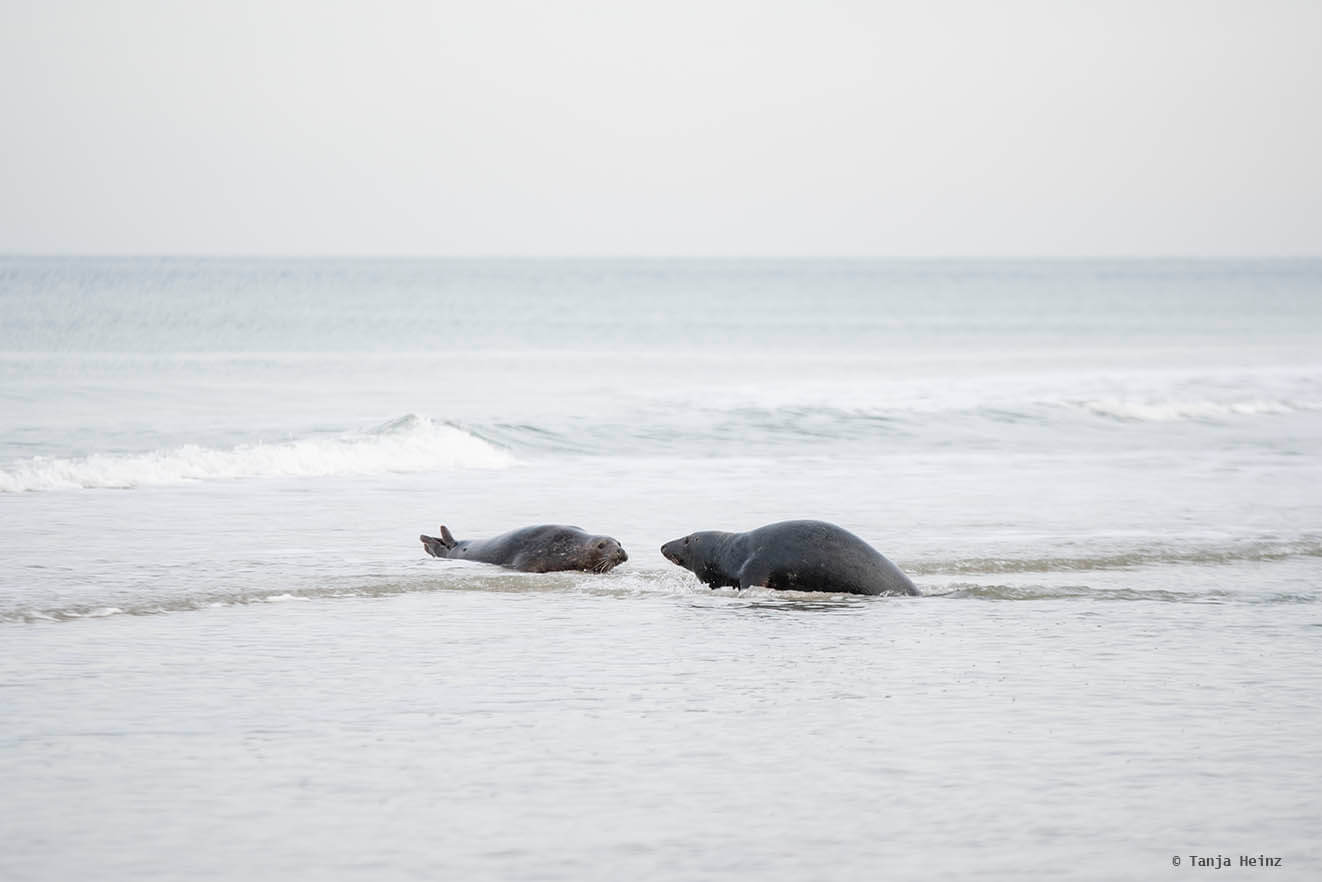
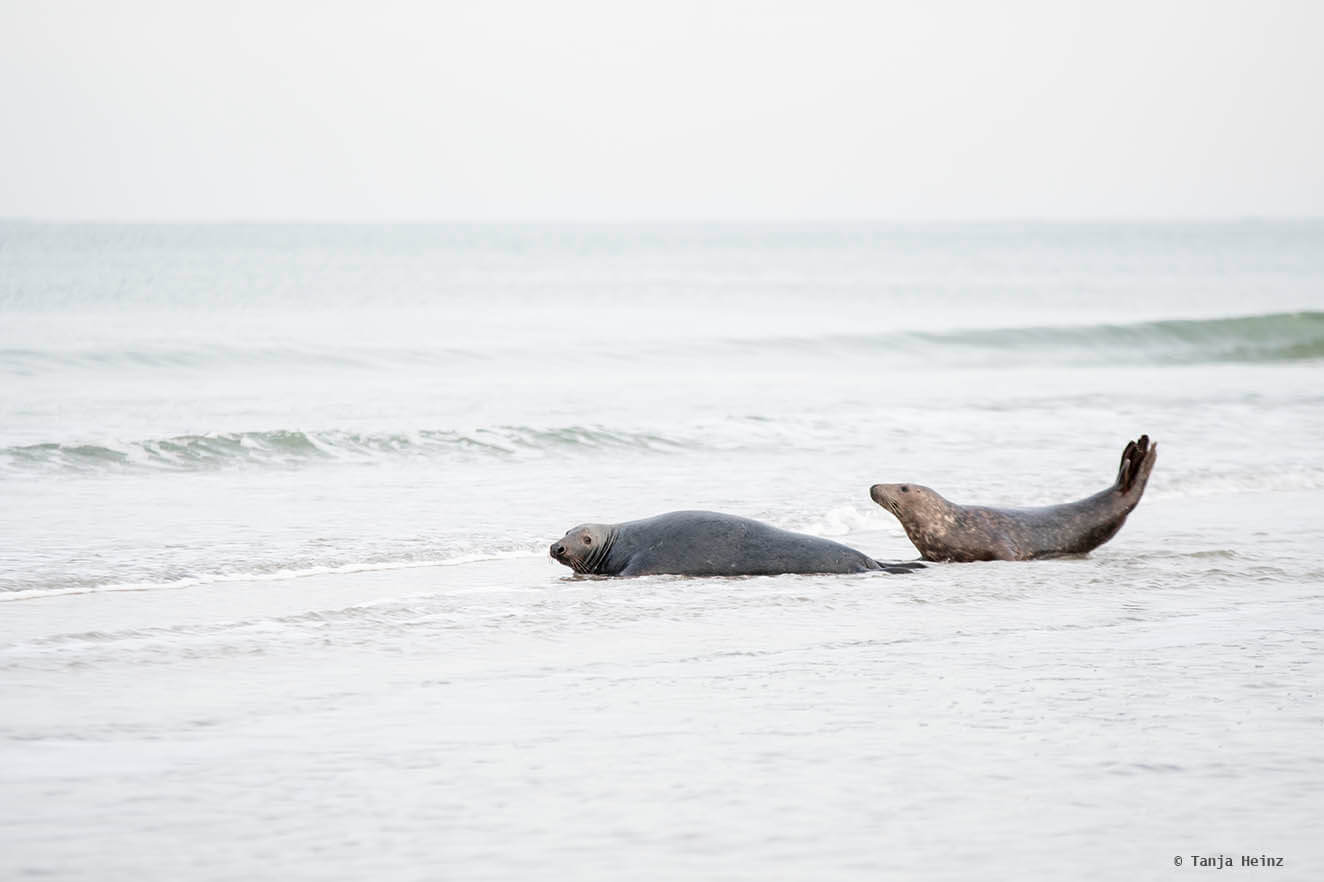
On my last day I could even observe them mating.
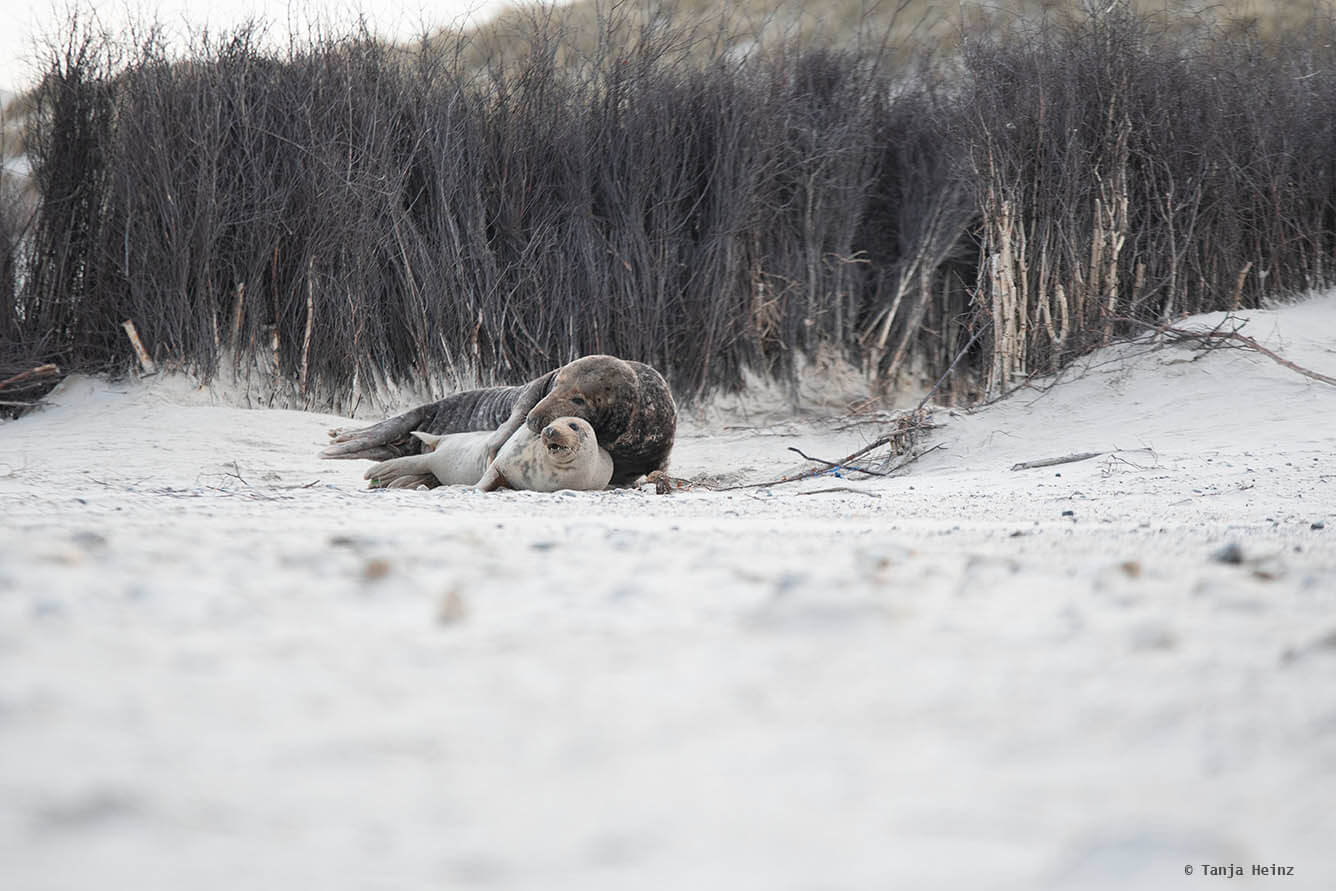
Well, you see that if you take your time you can observe quite many behaviors among these grey seals.
Tip: I haven't participated in any guided tour, but if you want to do so, try to check the website of Jordsand. As the main cubbing season starts in November, most tours might be offered in November and December.
Birds on the Düne
Heligoland is also a popular place for bird watchers. Especially from spring to autumn. In spring and autumn Heligoland is an important roosting place for songbirds and in summer seabirds like gannets or guillemots breed on the Lummen cliff (German: "Lummenfelsen") - a rock with thousands of brooding seabirds in the western part of the high sea island close to Long Anna. As I have visited Heligoland in a winter, I could not observe these birds. However, but still I could observe some bird species even in winter like, for example, ruddy turnstones (Arenaria interpre).


Actually, I saw this bird species quite frequently both on the Nordstrand and on the Südstrand, respectively.
Interesting: There are five bird species in Germany that brood only on Heligoland. These birds are common guillemots (Uria aalge), northern gannets (Morus bassanus), northern fulmars (Fulmarus glacialis), black-legged kittiwakes (Rissa tridactyla), and razorbills (Alca torda). You cannot find these birds brooding in other places in Germany. But about 10.000 breeding pairs of these seabirds brood on the Lummen cliff or on close-by rocks.
The most interesting place on the days of my visit with respect to birds was definitely the Südstrand. I was especially happy to see a common eider (Somateria mollissima). I very like their coloration and in general their appearance. I think, they are beautiful birds.

I was also happy to see an Eurasian oystercatcher (Haematopus ostralegus), as I'm mostly far from the coast, I do not see them very often. I think these birds are also very beautiful. In that moment I remembered the African oystercatchers (Haematopus moquini) I had seen in South Africa.
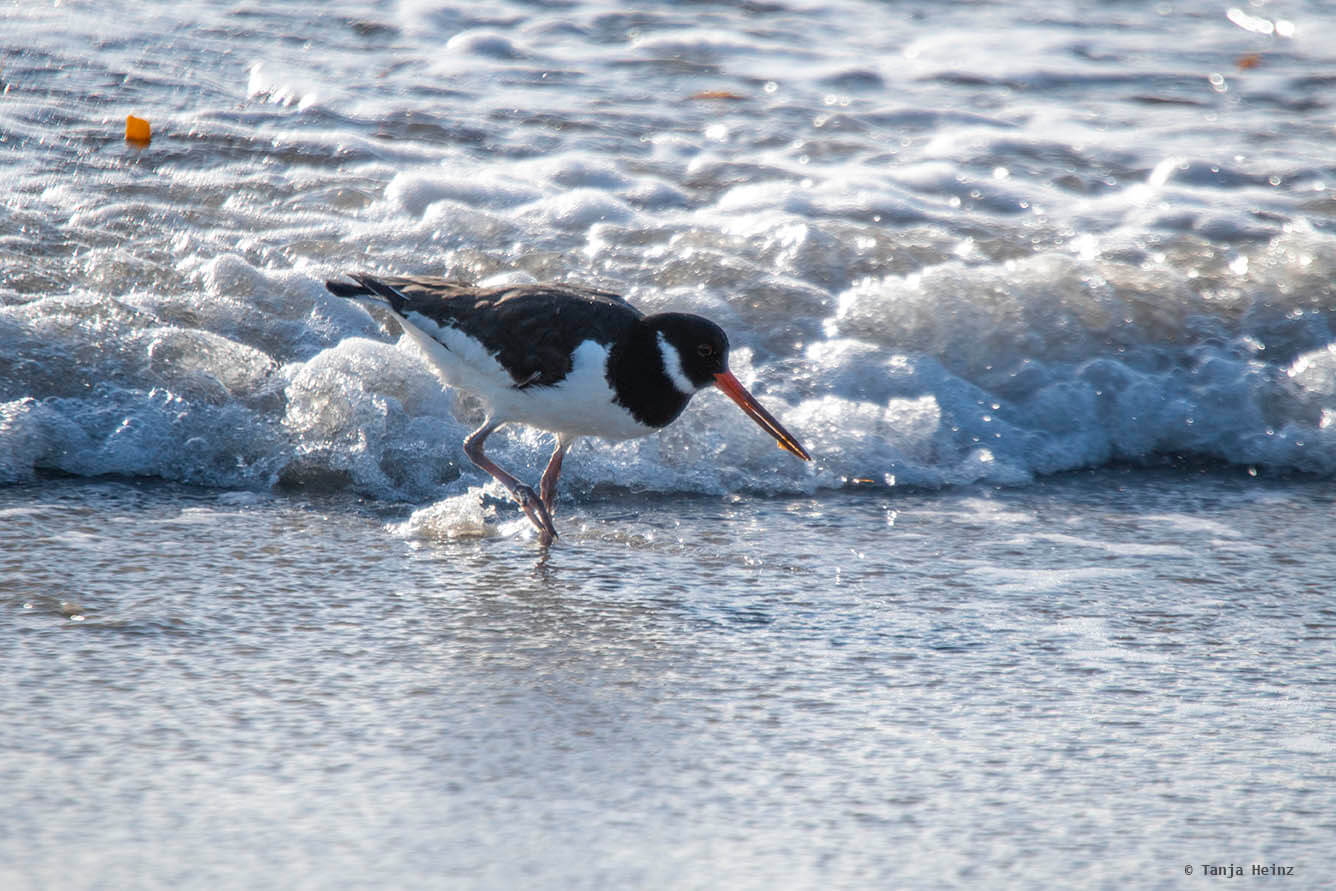
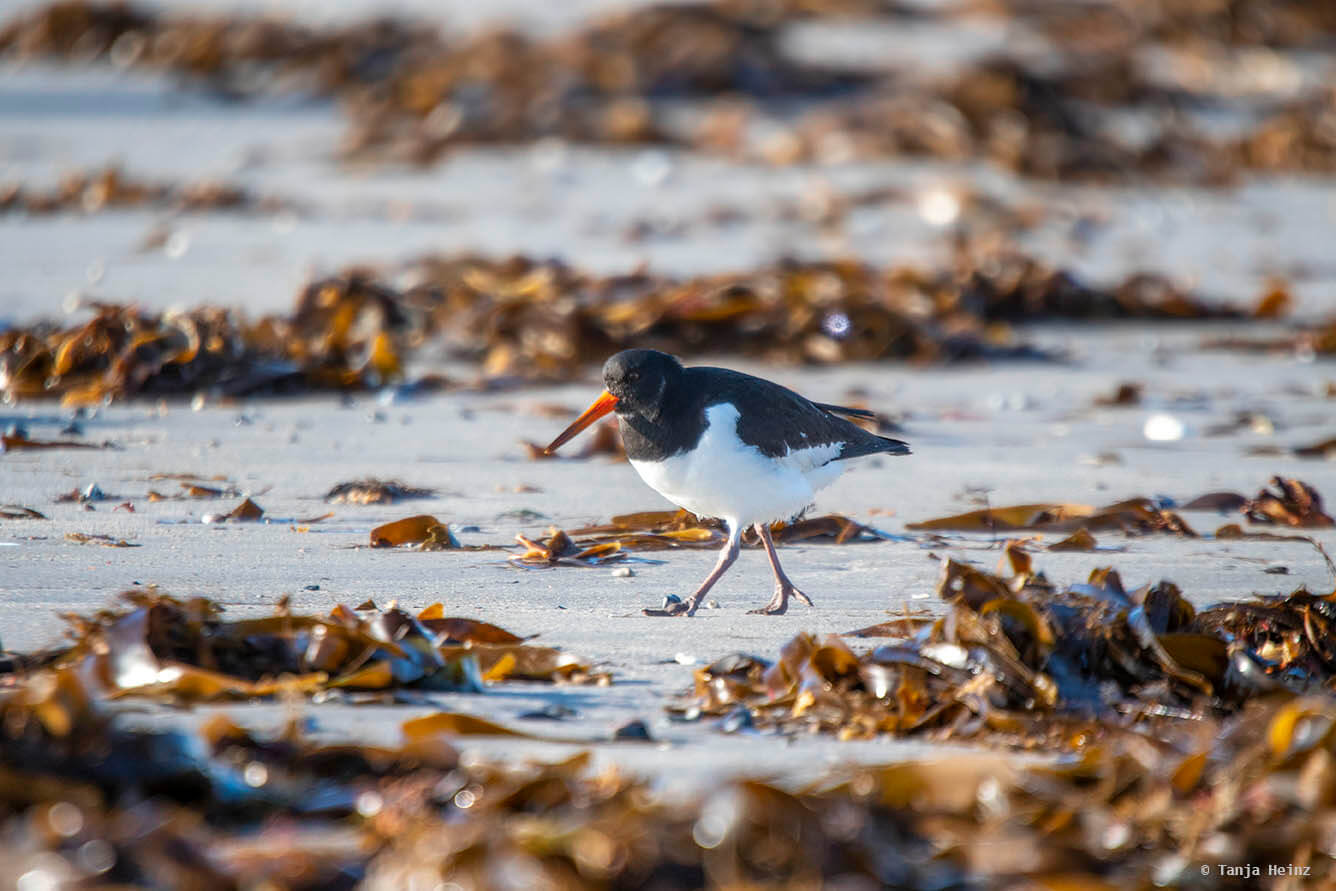
I also came across less prominent birds as they often seem so common like the Western Carrion Crow (Corvus corone ssp. corone).

On the Nordstrand I saw not only playing grey seals in the water, but also some herring gulls (Larus argentatus). I have to admit that I was more focused on the grey seals than on herring gulls or any other birds. Nevertheless, I also gave them some attention.

When I was waiting for the ferry on the Düne to go back to the mainland, I encountered a black guillemot (Cepphus grylle). I actually wouldn’t have expected to see an auk. But apparently, although this species lives usually in high arctic waters, sometimes it is forced further south due to the ice.

I can imagine that Heligoland must be a very special place in other seasons. I’m sure, this was not my last visit to Heligoland...
Harbor seals versus grey seals
If you stroll along the beach you most probably see a grey seal (Halichoerus grypus) in winter. However, sometimes you might even encounter another species of seal: common seals (Phoca vitulina). Although common seals mostly leave the beach for the grey seals in winter, now and then, an individual might lie on the beach. They might look similar (at least a little bit), and indeed, they do have some similarities. However, there are some distinctive features which help to distinguish both species from each other.
One of these distinctive features is definitely the size. A full-grown adult common seal reaches a size of only about 1.2 - 2 meters on average and a weight between 65 and 170 kilograms with males slightly larger than females.

In contrast, male grey seals can reach a size of up to 2,6 meters and a weight of 400 kilograms. With up to 2 meters and 250 kilograms, female grey seals are smaller than males (left photo: male, right photo: female)


Another distinctive feature between both species is their head. Common seals have a rather rounded head. Their muzzles look wide and blunt with a slightly upturned nose.

In contrast, grey seals do have nostrils (nose holes) being well apart. However, there are also some slight differences between both sexes among grey seals. Males do have a muzzle that broadens into a convex fleshy snout. The head of female grey seals are narrower and they do have only a slight convex muzzle (left photo: male, right photo: female).
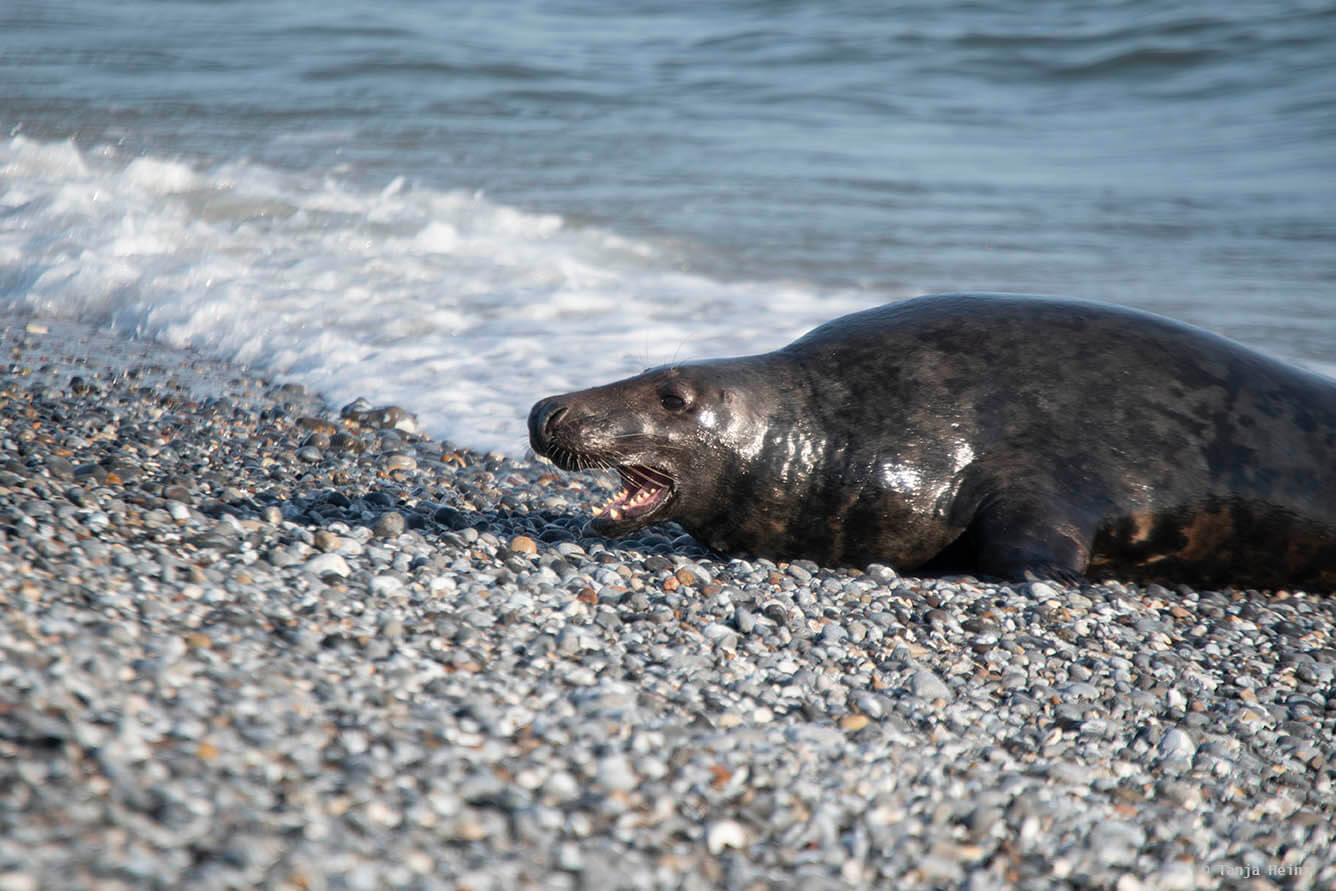

Both seal species do have one thing in common. Both belong to the family Phocidae. That means, both grey seals and common seals are true seals or earless seals, respectively. They can be distinguished from eared seals (Otariidae) like Australian sea lions (Neophoca cinerea) or New Zealand fur seals (Arctocephalus forsteri) in Australia or brown fur seals (Arctocephalus pusillus) in South Africa by the absence of ear flaps. Earless seals furthermore cannot rotate their hind flippers under their bodies. Therefore, earless seals like grey seals move rather slowly and awkwardly on land.

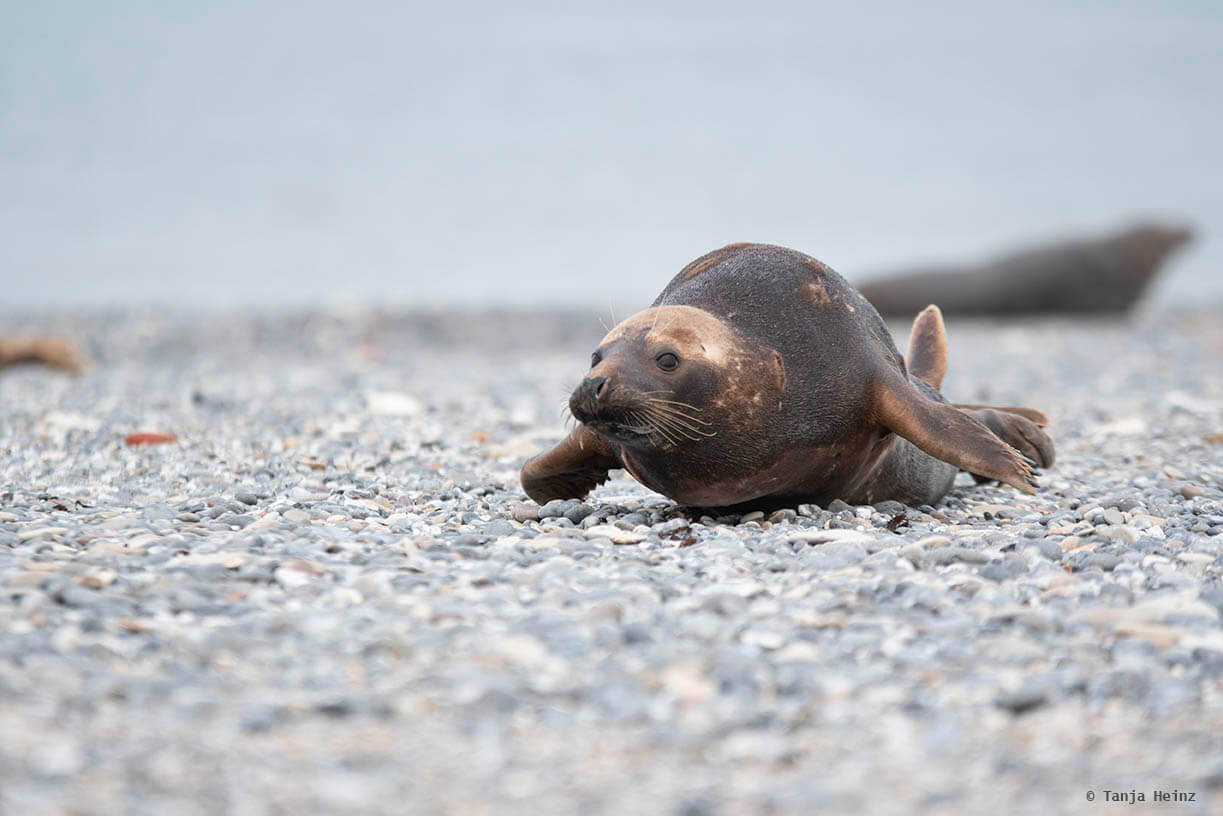
The common seal was definitely the less active species during my time on the Düne. I only saw some single individuals lying on the beach. And I have to admit that it was sometimes easy to oversee these animals, as they could be easily confused with a grey seal young from afar.
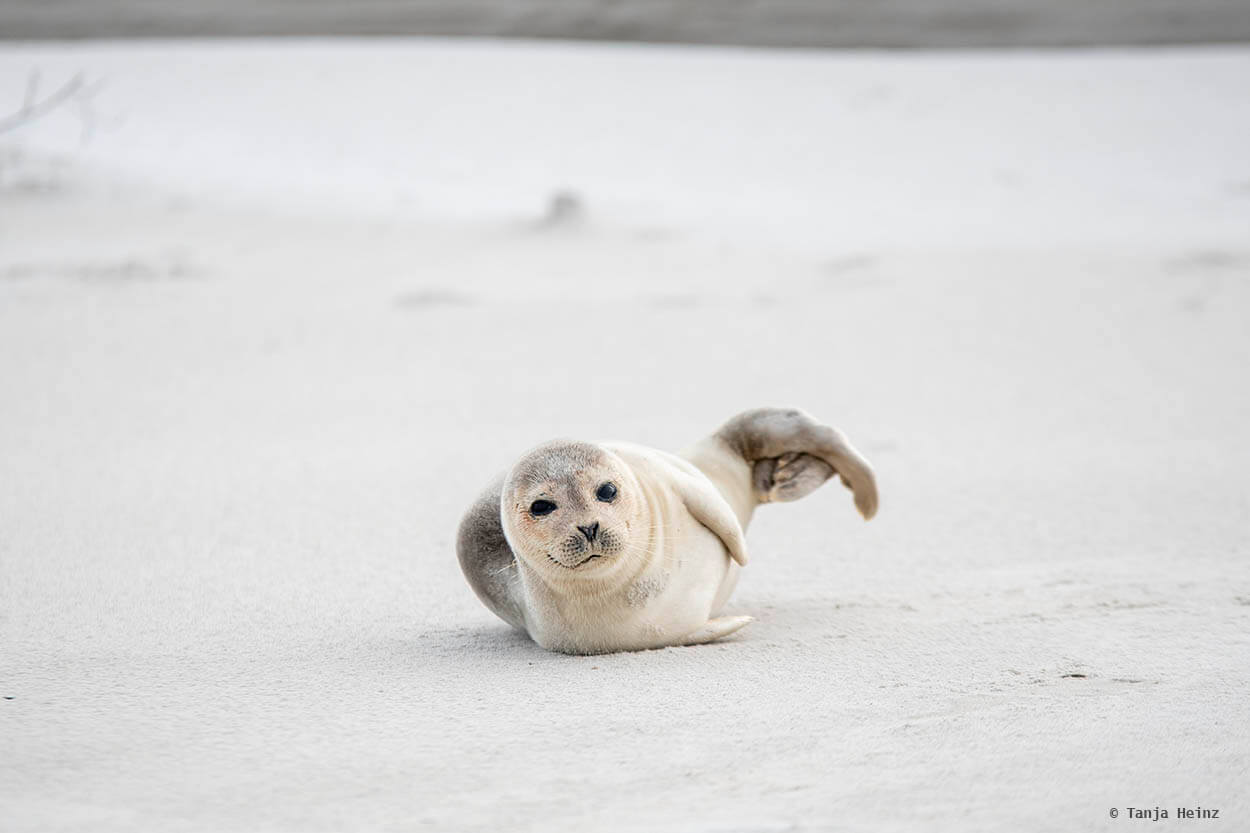
Apparently, there are more common seals in the summer months. As I haven’t been on Heligoland in summer, I cannot tell you here more about my experiences observing these animals on Heligoland. However, I’m sure that it was not the last time visiting this special place.
Tip: Please visit the official website of Heligoland to get more information about the seals on the Düne. They will not only answer most interesting facts about the biology of these two seal species, but also provide you with information about how to behave when observing them.
Practical Information for Heligoland
How to get to Heligoland
As far as I know there is only one ferry in winter to Heligoland. The company Reederei Cassen Eils operates daily between Cuxhaven and Heligoland year-round. The company also leaves in Bremerhaven, Büsum or Hooksiel in summer. But not in winter. Please check the website of the Reederei to get more information about the latest timetable. The ferry from Cuxhaven lands on the Südhafen on Heligoland and the journey takes about 2 to 2 ½ hours. I paid 52,00 Euros for one ticket (January 2019).
Embarking was fast and uncomplicated. Please check the website of the Reederei Cassen Eils to get more information about luggage regulations. As I traveled only with a hand luggage, a backpack for my camera, and a laptop case, I didn't have to check in my luggage.
If you are prone to sea sickness, you might want to make preparations. I found the journey in general quite calm, but after one hour, every passenger had to remain seated because of the waves.
Please note: There is no ferry from Cuxhaven to Heligoland on Sunday and from Heligoland to Cuxhaven on Wednesday and Saturday in winter. Most ferries leave at 4 p.m. I took one of these ferries and traveled back to Berlin by train on the same day.
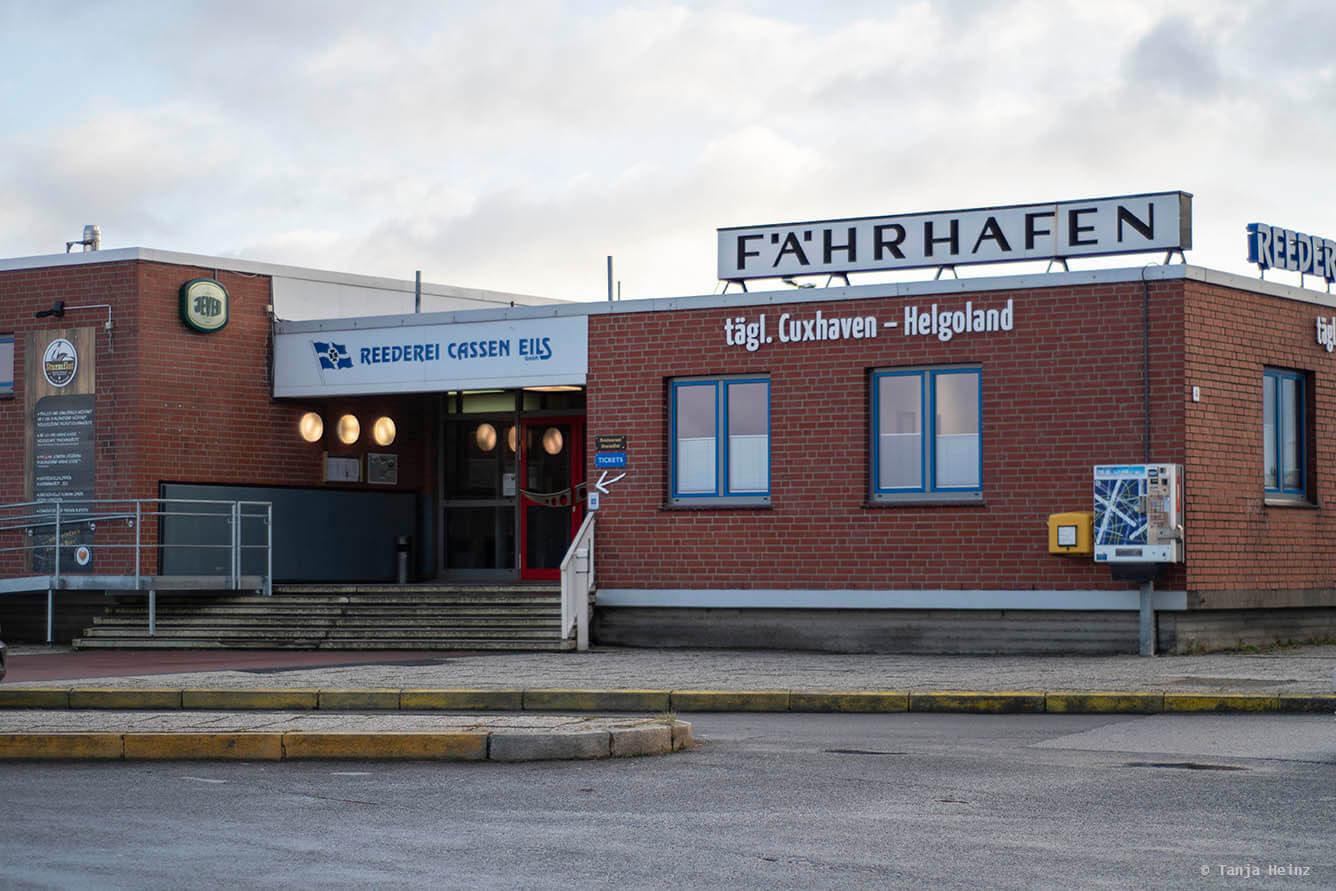
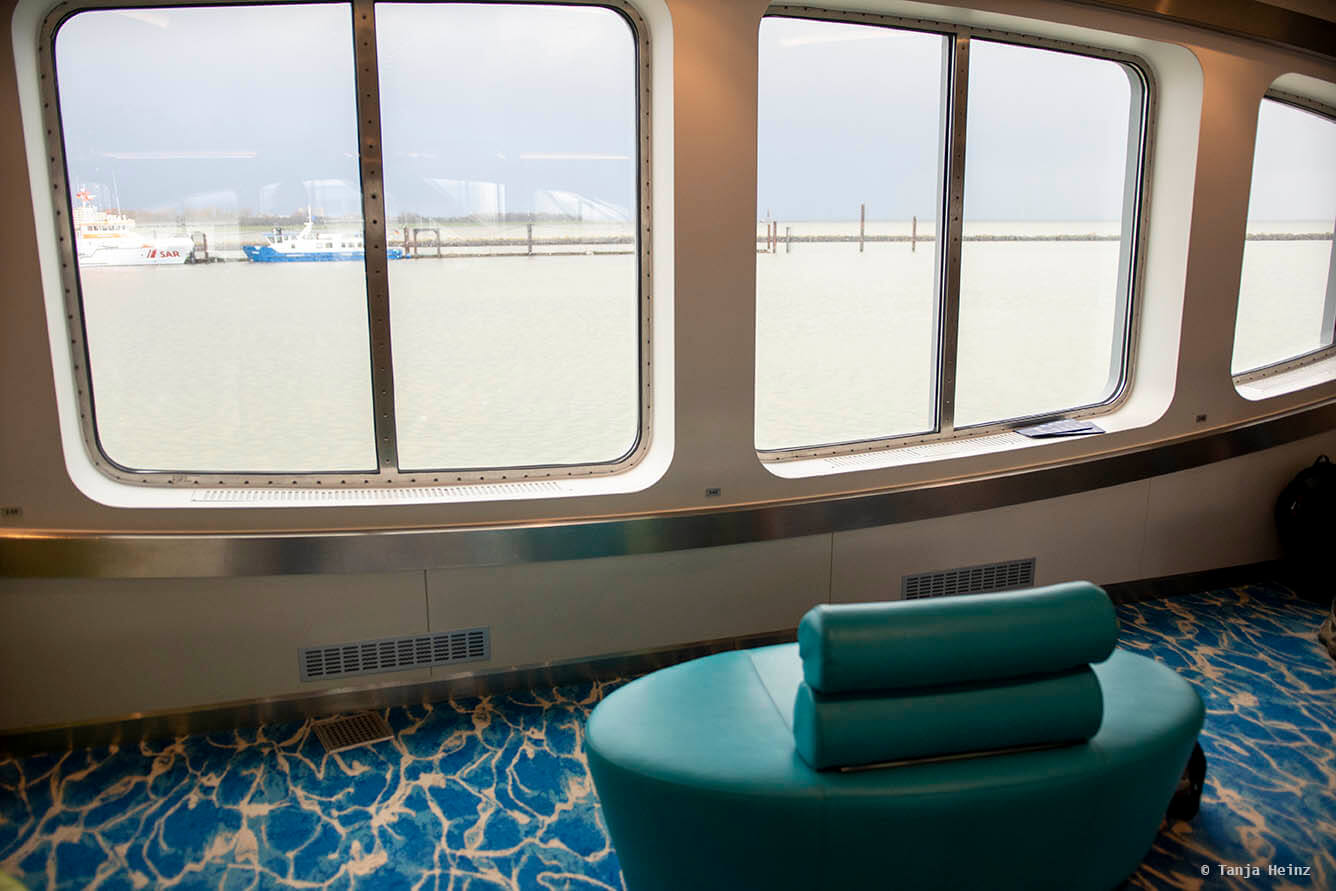
I arrived in Cuxhaven by train. As the ferry was only leaving in the morning at 10:30 a.m. and as I didn't want to stay overnight in Cuxhaven, I had to travel from Berlin to Cuxhaven during the night. There wouldn't have been other ferries to Heligoland. The journey by train took about eight hours from Berlin to Cuxhaven, but only six hours back. I paid 59,80 Euro for the return ticket. Although this way of traveling looks kind of exhausting (not everyone likes to travel during the night alone), for me it was the best option.
Tip: If you travel by train, the distance between the train station and the departure of the ferry (Am Fährhafen 4, 27472 Cuxhaven) is about 2 kilometers. As I had some time and as I haven't had so much luggage, I walked from the train station to the ferry. When I came back from Heligoland I took a taxi back to the train station, as I didn't want to miss my train. Apparently there is also a bus which operates between harbor and the train station.
Moving around on Heligoland
There is one really positive thing on Heligoland. You do not have to care much about how to get around on Heligoland, as the high sea island is so small and there is no road traffic, because cars are prohibited on Heligoland. You can reach everything easy by foot. However, if your accommodation is on the Upper Land, the path might be too steep for carrying luggage. Luckily, there is a lift where you can get from the Lower Land to the Upper Land. If you don’t want to use the lift, you can also get up and down on the staircases.
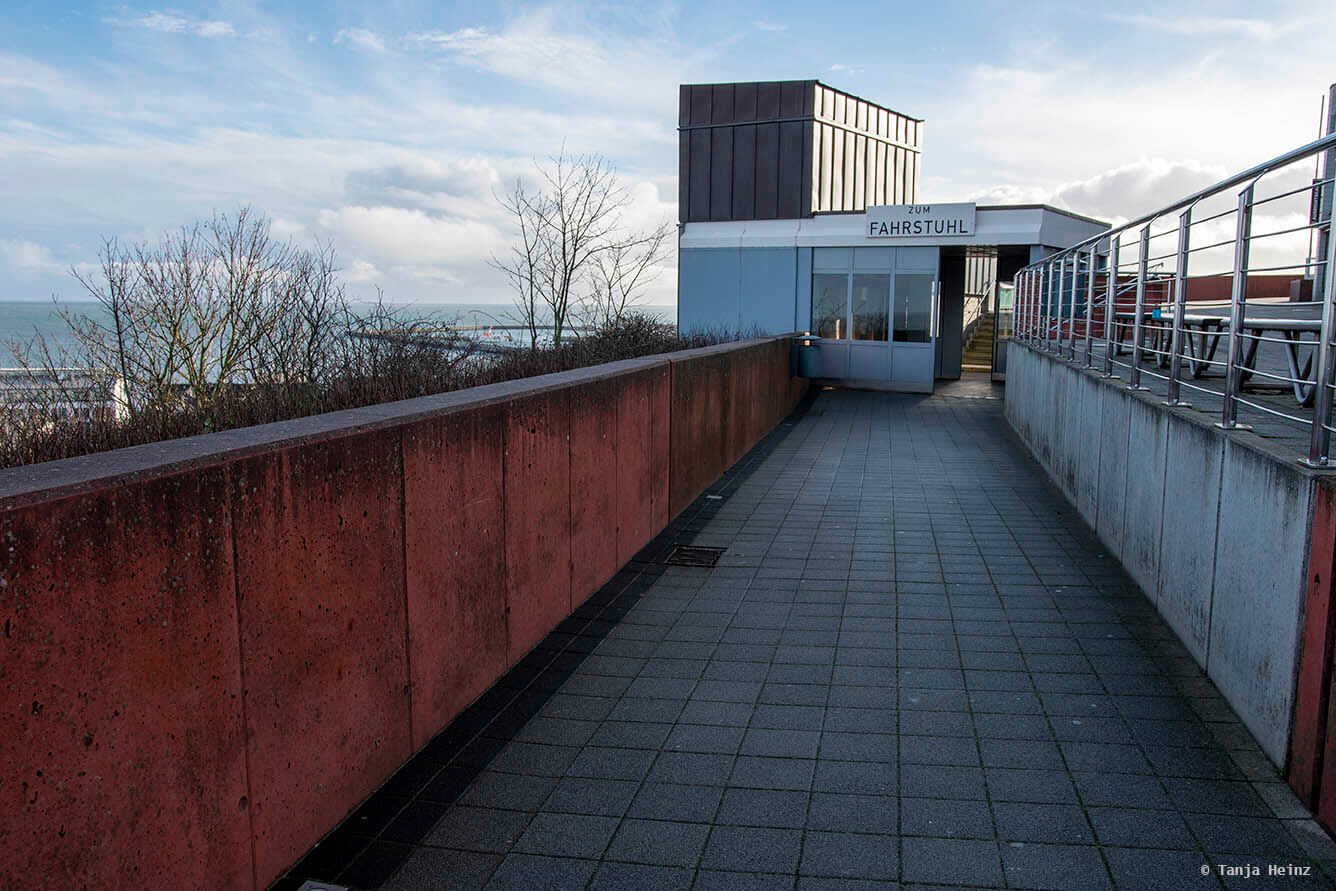

One ticket for the lift cost 0,60 Euro. However, there are also discount tickets if you buy 12, 50 or 100 lift rides in advance. As I haven’t used the lift, I cannot tell you here my experiences about how everything works with the lift.
If you want to get from the mainland to the Düne, you have to use the small ferry (German: "Dünenfähre") which operates daily year-round, but depending on the weather. One ticket costs 6 Euros. Please check the official website of Heligoland to get the up to date timetable and prices.

Please note: The ferry between Heligoland and the Düne leaves either at the jetty (German: "Landungsbrücke") or in the north east harbour (German: "Nordosthafen"). You have to check the information on site. The ride between Heligoland and the Düne takes about 10 minutes.
Where to stay in Heligoland
There are several hotels or other accommodations in the Lower Land, and I guess, they are very popular. However, I stayed in the Upper Land and I was very happy with my choice. It was a really nice accommodation. After a long day outside I could relax in this beautiful, clean and comfortable place. It was a small guest-house in the middle of the village. The name of the guest-house is "Haus Sabina" and located in the street Am Staenaker 602, 27498 Helgoland. I stayed four nights in this accommodation and paid 166,00 Euro for one person.
More resources about grey seals and Heligoland
Other blog articles about grey seals and Heligoland:
Northern gannets and harbor seals on Heligoland
Helgoland im Winter - Babyzeit bei den Kegelrobben (only in German)
Robben fotografieren auf Helgoland (only in German)
Der Seehundjäger (only in German)
Grey seals in the Bay of Wismar
Book recommendation:
Whales, Dolphins and Seals - A Field Guide to the Marine Mammals of the World by Hadoram Shirihai and Brett Jarrett
Online resources:
Association Jordsand (only in German)
Grey seals on Wikipedia
Official website of Heligoland (only in German)
Have you ever been on Heligoland to see grey seals? Or have you seen grey seals at another place? Let me know in the comment area.


